Damien Parer – a Bungan Beach and WWII War Photographer
Anzac Day 2024 Precursors

Portrait of Damien Parer on Bungan Beach, N.S.W., c 1930s by Max Dupain Retrieved from http://nla.gov.au/nla.obj-146284708
Damien Peter Parer (August 1st 1912 – September 17th 1944) was an Australian war photographer. He became famous for his war photography of the Second World War, and was killed by Japanese machine-gun fire at Peleliu, Palau. He was cinematographer for Australia's first Oscar-winning film, Kokoda Front Line!, an edition of the weekly newsreel, Cinesound Review, which was produced by Ken G. Hall.
Damien Parer was born at Malvern in Melbourne, the seventh child of John Arthur Parer, a Spanish-Catalan-born hotel manager on King Island, Tasmania, and his wife Teresa, the daughter of John Paul Carolin a Tasmanian who had settled in Bendigo by the time of their marriage and Mary Corcoran from Tipperary, Ireland.
His father had emigrated as a 15 year old to join other family members in Australia who were engaged in the hotel and catering business.
His grandfather on his mother's side was also a photographer. John Paul Carolin was born 12th June 1835 at Hobart Town, Van Diemen's Land, Australia, the son of Hugh Carolin and Margaret Gilchrist.
This was not the only connection between the Carolin and Parer families;
MARRIAGES AT ST. KILIAN'S.
Yesterday morning, the marriage of Miss Carolin, eldest daughter of Mr J. P. Carolin, and Mr Michael Parer, of Melbourne, which created a considerable amount of excitement amongst the fair sex in the city, was celebrated at St. Kilian's Pro-cathedral, by the Very Rev Dean Davey. There was a large number of onlookers. In the absence of the bride's father, who was unable to leave his house owing to severe illness, the Rev Mr McCulloogh gave the bride away. The brides maids were the Misses Carolin (3) and Berges.
The bride was attired in an elegant costume of ivory satin, the front of the skirt being trimmed profusely with lace and ribbon. The lace draperies were looped up with myrtle and orange blossoms, and the long flowing train was trimmed with a niching of lace. A handsome veil and wreath of myrtle and orange blossoms completed the costume. Miss Agnes Carolin wore a dress of cream satin trimmed with lace; veil and wreath of marguerites. Misses Theresa and Veronica Carolin wore white, muslin dresses, trimmed with pale blue merveilleux; wreaths of daisies. Miss Berges wore a costume of cream broche and Indian muslin, with veil and wreath of marguerites. Mrs Carolin's dress was of ruby velvet and broche, with bonnet to match.
The bride's travelling dress was composed of bronze green and gold-striped merroilleux, hat to match trimmed with ostrich feathers. The whole of the trousseau was made at the establishment of the Misses Blyth and Leonhardt. After the ceremony the wedding party adjourned to the residence of the bride's parents, whore the wedding breakfast was partaken of, and future happiness of the newly-married couple hoped for on all sides. Mr and Mrs Parer left for Melbourne by the afternoon train, thence for Tasmania, where they are to spend the honeymoon. In the evening Mr and Mrs Carolin entertained a large number of friends at their residence, Queen-street, where a very pleasant evening was spent. MARRIAGES AT ST. KILIAN'S. (1885, October 8). Bendigo Advertiser (Vic. : 1855 - 1918), p. 3. Retrieved from http://nla.gov.au/nla.news-article88654746
His parents marriage:
Marriages.
PARER-CAROLIN.-The marriage of Miss A. Teresa Carolin, fourth daughter of Mr. J. P. Carolin, of Bendigo and Melbourne, with Mr. John A. Parer, third son of Mr. Antonio Parer, of Melbourne, took place—after a nuptial mass had been celebrated—at St. Mary's Roman Catholic Church, East St. Kilda, on Thursday morning, November 21. The "Tantum Ergo" was played on the organ by Miss Letcher. The bride was given away by Mr. John Paul Carolin, junior, and was attended by two bridesmaids—Miss Angeletta Parer (sister of bridegroom) and Miss Elsie Hewitt (cousin of bride.) The Rev. Father Lynch officiated.
The bride wore a tasteful gown of white muslin trimmed with Valenciennes lace and insertion finished with a lace fichu. She wore a tulle veil with a spray of orange blossom, and carried a shower bouquet. The first maid-Miss Parer wore a cream silk costume with a blouse of blue flowered silk, and a large leghorn hat trimmed with roses. Miss Elsie Hewitt wore a gown of pale pink veiling trimmed with white satin, and wore a wreath of lilac in the hair. The groomsmen were Mr. Francis Parer (brother of bridegroom), and Mr. W. of the ceremony Miss Letcher played the Wedding; March. The party then proceeded to "Normanstone," Windsor, the residence of Mr. and Mrs. Carolin, where a breakfast was served in a marquee on the lawn, only the near relatives of the bride and bridegroom being present. Mr. and Mrs. John Parer are spending the honeymoon at Blue Mountains, New South Wales.
Her presents are as follows:-
Mrs. Carolin (mother), linen. Mr. Carolin (father), piano. Mrs. A. Parer, dinner set. Mr. A. Parer, water fount. Mr. and Mrs. Philip Parer, marble clock. Mr. and Mrs. Stephen Parer, one dozen each solid silver spoons: and forks. Mrs. Cabus, photo and frame. Mr. Francis Parer, senior, ornaments (pair). Mrs. E. Clota, pair of ornaments. Mr. and Mrs. Hewith, Parian marble statuettes. Mr. and Mrs. Higgins, E.P. tea and coffee service. Mr. and Mrs. M. Parer, E.P. and oak salad bowl. Mr. Francis Parer, junior, E.P. bread board, knife and case of carvers. Mr, Frank Parer, Dresden water fount. Mrs. S. Barbeta, E.P. tete-a-tete service. Mr. S. Parer, junior, E.P. gong. Mr. and Mrs. A. Barbeta, E.P. cream and sugar stand. Mr. and Mrs. Rubira, E.P. water jug. Mr. and Mrs. Amat, E.P. jam dish. Mr. and Mrs. H. C. Wright, enamelled photo frame (for six photos). Employees Carolin and Company, (Bendigo), platform rocker. Mr. and Mrs. S. Jenkenson, E.P. cruet. Mr. Warren, E.P. cruet. Mr. and Mrs. San Miguel, E.P. cruet. Mr. L. Beer, E.P. cruet. Mrs. O'Connell, E.P. cruet. Mr. and Mrs. Hurst, case desert knives and forks. Com munity Presentation Nuns (Hobart), volume Btauti ful Britain. Mr. and Mrs. Eaculte, hot water kettle. Rev. Father Kelsh, views of Hobart. Miss Kate Hayes, E.P. jam dish. Miss M$ud Walsh, glove and handkerchief sachet. Miss Pallett, jardiniere. MisseB Berges, painting. Misses Christensen, paint ing. Miss Maggie King, volume Shakspeare. Miss Ethel Roberts, point lace d'oyley and tray cloth. Misses Brown, Mount Mellick tray cloth with initials. Miss Hunter, ease E.P. preserve spoons. Miss Jolley, set meshed d'oyleys. Mrs. Alacoque, book marker. Miss A. Parer, Dresden ornaments. Miss Coy, bronze card tray and pair salts. Miss Teresa Power, album. Master M. B&rbeta, E.P. pepper castor. Mrs. Kennedy, pair plaques. Misses Lawler, jam dish. Mr. McCarthy, Corona photo frame. Mr. and Mrs. Sadewasser, E.P. butter dish. Mr. and Mrs. Arenas, pair hand mirrors. Mr. and Mrs. Wiesbaden, Dresden ornament. Misses Gaff ney, silver ash tray. Miss Fitzgerald, pair brass candlesticks and cake dish. Miss Pepin, toilet set. Mies Sykes, set of ornaments. Misses McLellan, set of ornaments. Mrs. Vila, case afternoon teaspoons and tongs. Miss Eva Robinson, tray cloth, Mont Mellier. Mrs. Woods, evening wrap. Mr. W. Carolin, photo frame.
CONNELLEY—CAROLIN.—The marriage of Miss Agnes Carolin, second daughter of Mr. J. P. Carolin, of Bendigo and Melbourne, and Mr. J. Thomas James Connelley, eldest son of the late Mr. Michael Connelley, of Belfast, took place at St. Mary's Roman Catholic Church, St. Kilda, on Thursday afternoon, November 21. The Rev. Father Lynch officiated, and the bride was given away by her father. There were two bridesmaids—Miss Vera Carolin (sister of the bride), and Miss Elsie Hewitt (cousin of the bride). The bride was dressed in a gown of white muslin trimmed with lace and insertion, wearing a I wreath and veil. She carried a charming bouquet i of white blossoms. Miss Vera Carolin, the first maid, wore a gown of white swiss embroidered tnuslin, and a large chip hat set off with white wings and chiffon. She carried a posy of pink and White flowers. Mr. Francis Parer and Mr. W. Carolin acted as groomsmen.
After the wedding the bridal party proceeded to " Normanstone," Windsor, and after the dtjeuner Mr. and Mrs. Connelley left on a wedding tour for Kyneton, Bendigo and Ballarat.
The following, is the list of presents: I Mrs. Carolin (mother), linen, pair pictures, pair ornaments. Mr. Carolin (father), piano. Mr. and Mrs. Stephen Parer^silver epergne. Mr. and Mrs. Philip Parer, case carvers. Mr. and Mrs. Hewitt, tea set and ornaments. Mr. and Mrs. Higgins, silver-plated tea and coffee service. Mr. and Mrs. M. Parer, silver-plated gong. Mr. Frank Parer, Dresden water fount. Mr. Francis Parer, serviette rings. Mrs. S. Barbeta, E.P. butter dish. Mr. S. Parer, junior, pair bronze figures. Mr. and Mrs. A. Barbeta, E.P. cream and sugar stand. Mr. and Mrs. James Rubira, E.P. pickle cruet. Miss Coy, bronze card tray and pair salts- Misses Christensen, painting. Miss Power, ornaments. Miss Pallett, jardiniere. Mr. Warren, E.P. fruit dish. Mr. and Mrs. H. C. Wright, plaque and album. Mr. and Mrs. J. S. Jenkinson, E.P. and pearl knife rests. Misses Brown, Mont Mellick tray cloth with initials. Misses Gaffneys, case preserve spoons. Mrs. O'Connell, marble clock. Enployees Carolin and Company (Bendigo), platform rocker. Miss Jolley, set meshed d'oyleys. Miss Reynolds, Dresden water fount. Mias Berges, painting. Misses McLellan, E.P. and oak butter dish. Mrs. Vila, butter knives. Family Notices (1895, November 29). Table Talk (Melbourne, Vic. : 1885 - 1939), p. 9. Retrieved from http://nla.gov.au/nla.news-article145921196
Damien spent his early years on King Island and then he and his brother Adrian were sent as boarders to the Loretto Nuns, St Aloysius College, Portland, Victoria from 1918-1922. The Parer family then moved to Albury, New South Wales, in 1923 and Adrian and Damien were sent as boarders to St Stanislaus College, Bathurst, NSW.
His elder brother's recollections are that in 1926 the old family nursemaid presented him with a small Kodak box camera and it was at college that he began his first simple experiments in the art which was to make his name. He joined the school's camera club, and decided that he wanted to be a photographer, rather than a priest. Later the family returned to Melbourne and Damien finished his education at CBC East St Kilda and St Kevin’s College, Toorak.
While at this school he won a prize in a photographic competition run by the Melbourne newspaper The Argus, and used the money to buy a Graflex camera used by professional photographers.
Damien left school as a 17 year old. He spent six months early training at the studio of Spencer Shier and then apprenticed for four years to Dickinson-Monteath of Melbourne of 1929-1933. About this time he was reading everything he could on cinematography and was fired with the ambition to ultimately break into movies.
In mid-1934 he obtained work with the director Charles Chauvel on the film Heritage, where he met and became friends with another up-and-coming filmmaker of the time, John Heyer.
The Magic Shoes followed - a 1935 Australian short film based on the fairy tale Cinderella. It features the first screen performance by Peter Finch and Helen Hughes, daughter of former Prime Minister William Hughes and was the first dramatised movie to be shot at the National Studios, built to make The Flying Doctor (1936). The crew included future war photographer Damien Parer and among the cast were Phil Smith, father of actor Mona Barrie; Peter Dawson, a New Zealand comedian, dancer and eccentric dancer; and a number of children who were students at an acting school run by director Claude Flemming with Frank Harvey.
Filming finished by November 1935. It was originally scheduled for 11 days and finished in eight.
He helped film many Australian pictures including those already mentioned along with “Uncivilised”, and “Flying Doctor”. He also worked on the preliminary scenes for “Forty Thousand Horsemen”. In September 1935 Damien was offered and accepted via telegram the Assistant Cameraman position on Chauvel's film Rangle River.
At the conclusion of that film, and with the help of Chauvel, he obtained work in Sydney, and so moved there in 1935.
Here he met and worked at Max Dupains' studio in Bond Street Sydney, commencing there in October 1938 after photographer Geoffrey Powell, another Tasmanian born artist, left his position there to pursue a life at sea, unsuccessfully. Dupain had opened his own photographic studio at 24 Bond Street, Sydney, in 1934 and quickly established a reputation as Australia's leading modern photographer. Damien said later that he learned most about photography from Arthur Dickinson and Max Dupain.
Photos of Damien on Bungan Beach during the late 1930’s, taken by Dupain, are held by the National Library of Australia and State Library of NSW. The Dupain family had a house at Newport at that time. Lot 35, 15 Calvert Parade Newport, first part of the acreage sold by Thomas Copley Calvert to the Intercolonial Investment Land and Building Company in 1910, and consequently sold to Barbara Wallace Brooks as part of the Calvert Ocean Beach Estate subdivision, was then onsold to Harriet Margaret Wilson in January 1920 and then, on May 3rd, 1920, purchased by Thomasine Jane (Ena) Dupain, Max Dupain's mother. This became the weekender and retirement home of the Dupain family. It was only sold out of the family after Max passed away.
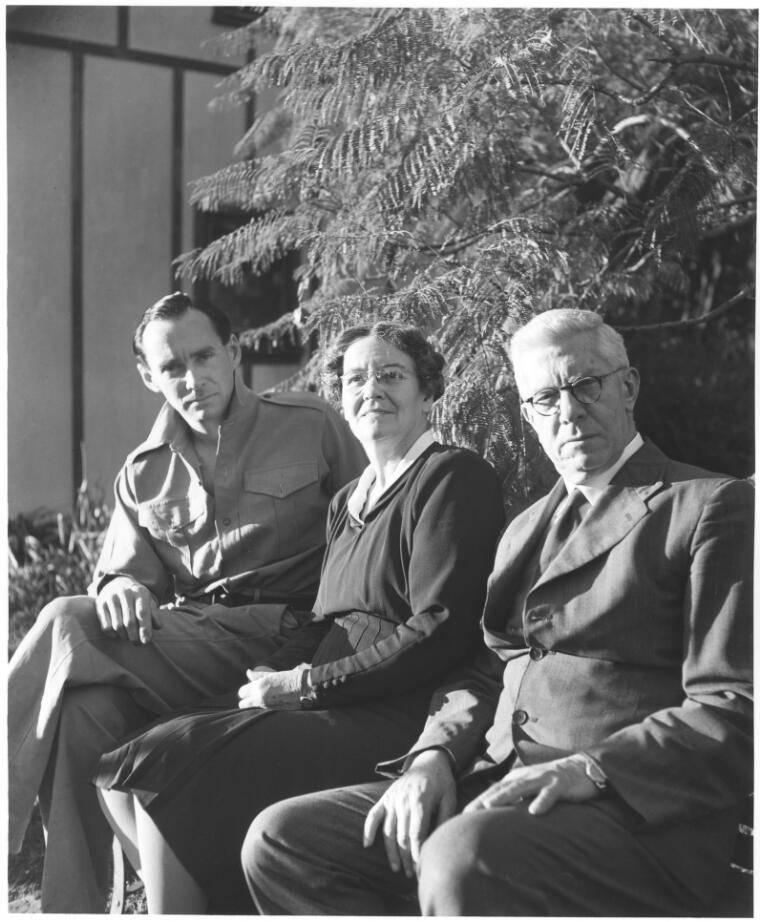
Although the Dupains would rent the home out, during the six weeks over Christmas and at other times during the dead of winter or at Easter, this was where they spent their time during many of their Summers at the beach. Max’s photos of Newport date from 1923 on, although most biographies of him state he did not get given a camera until 1924. His Newport images chart all the styles he tried out while evolving his practice.
The situation of the block, and weekender, close to 'Crossways' and the summit of the Newport/Bungan hill allowed access to both beaches with numerous photos taken over the decades Max Dupain's family would visit and live, enjoying the seaside.
Bungan beach, as with Newport and all of the beaches and estuary and lagoon areas from Palm Beach to Manly, persisted as subjects for his camera, including this one of Damien at Bungan Beach in the Spring or Summer of 1938:
.jpg?timestamp=1713135087531)
Damien Parer, Phyl Riley, Jenny Brereton at Bungan, 1938 – photo taken by Max Dupain - courtesy Mitchell Library State Library of NSW Phyllis and Jenny were friends of Olive Cotton who would soon marry Max Dupain - they had met at Newport in 1924
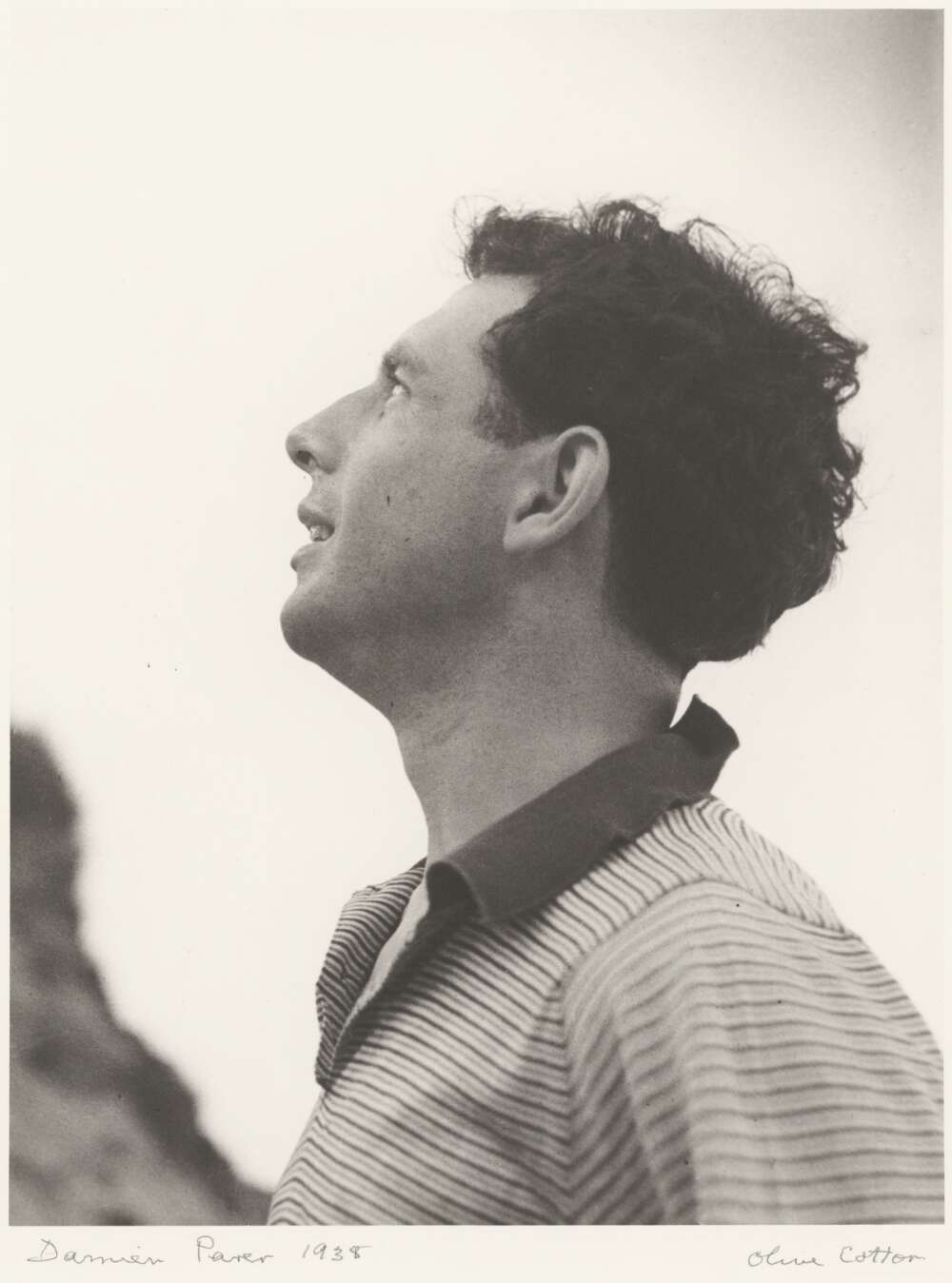
Damien Parer at Bungan Beach, photographed by Olive Cotton, 1938. Photo courtesy National Library of Australia
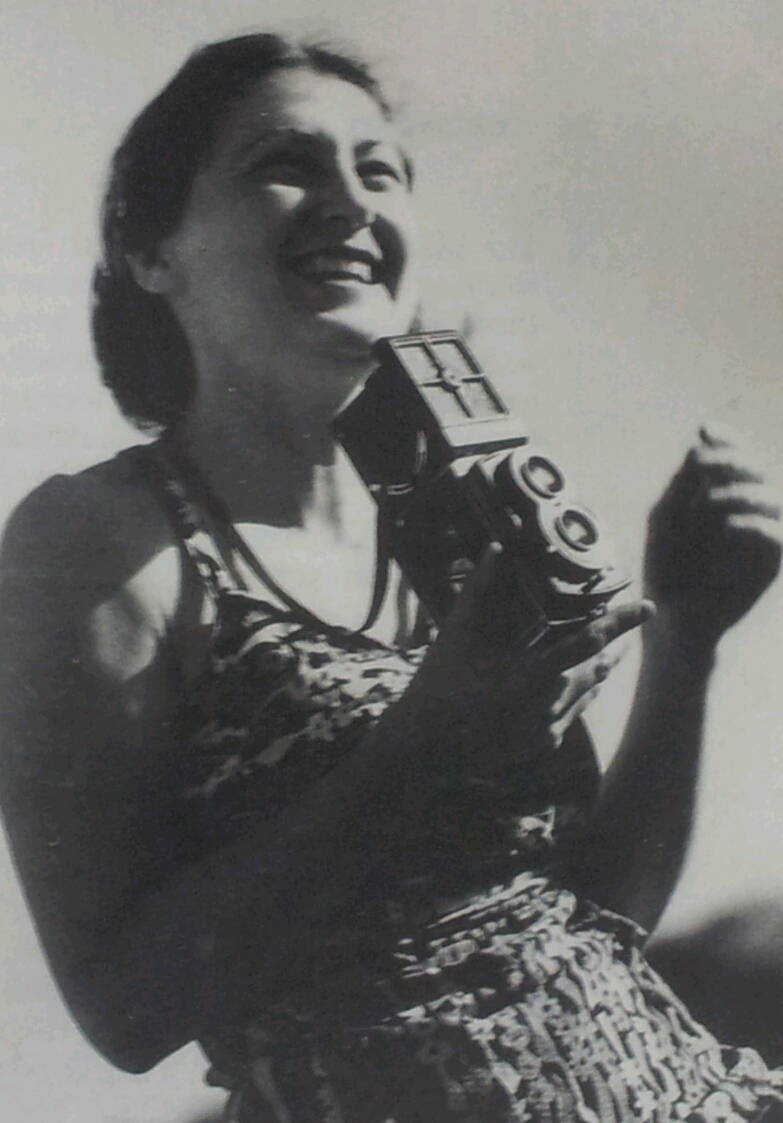
Olive Cotton, photographed by Damien Parer
In the late 1930’s Damien Parer, Max Dupain and Olive Cotton were part of the newly formed ‘Contemporary Camera Groupe’ which sought to add a progressive narrative to the prevailing conservatism of Australian photography. Members included:
CAMERA GROUP.
The first exhibition by the Contemporary Camera Group will begin on Monday. Among those represented in the collection, which will be hung in the Exhibition Gallery at David Jones's Market Street store, will be Max Dupain, William G. Buckle, Olive Cotton, and Douglas Annand. There will be no charge for admission to the display, which will remain open daily during store hours until December 31. CAMERA GROUP. (1938, November 19). The Sydney Morning Herald (NSW : 1842 - 1954), p. 18. Retrieved from http://nla.gov.au/nla.news-article17539068
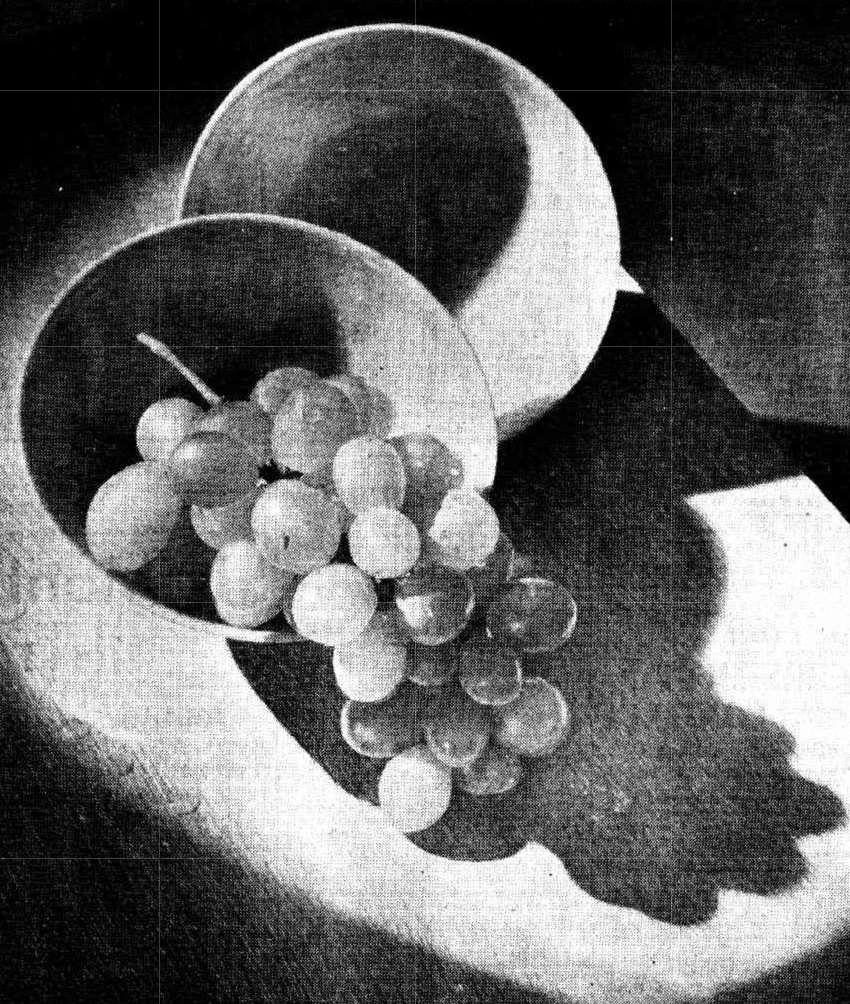
CAMERA ART. A Laurence Le Guay still-life study among the Contemporary Camera Group exhibits to be seen at David Jones' art gallery next Monday. No title (1938, November 19). The Daily Telegraph (Sydney, NSW : 1931 - 1954), p. 1. Retrieved from http://nla.gov.au/nla.news-article247433739
Their first exhibition reviewed:
CAMERA ART.
Contemporary Group.
EXHIBITION OPENED.
The first exhibition of the Contemporary Camera Group was opened yesterday at David Jones's Market Street store.
Prejudice against the camera is still rife and may rob this exhibition of much of the missionary purpose of its sponsors who say:
"We are trying to strengthen the liaison between photography and the other arts.
" Many of our photographic artists including one or two members of this group are still acutely self conscious. Their work is not sufficiently detached from personal motives of display.''
Max Dupain's work is sincere and some of it is distinguished, particularly "The Ballerina," which has a Degas like quality. In his portraits he emphasises a point subtly and delightfully.
MR. CAZNEAUX'S TECHNIQUE
Mr Cazneaux uses a printing technique which seems to dissolve some of his beautifully chosen landscapes into an etched effect that often loses vitality. One landscape and "Industry" are appealing.
Mr. Cecil Bostock in "The Quest," shows a cat wending its way between the posts of a fence and again in "Octogenarian Adventure," an old man's feet on the brink of an escalator. "Sparkling Cadence" and "Transient" are good landscapes.
Mr. Le Guay has in the past been disposed to a reckless bravura. Now, he has organised some good qualities, and in "Still Life" and "Street Scene" there is a note of sincerity.
Miss Olive Cotton's landscapes are simple, sincere and competently done, and Messrs. Louis Witt, Damien Parer and W.G. Buckle have hung pictures of interest.
Some highly original water colours and oils by Douglas Annand and A.E. Dodd occupy two panels and offer contrast.
The exhibition continues until December 10. CAMERA ART. (1938, November 22). The Sydney Morning Herald (NSW : 1842 - 1954), p. 2. Retrieved from http://nla.gov.au/nla.news-article17539837
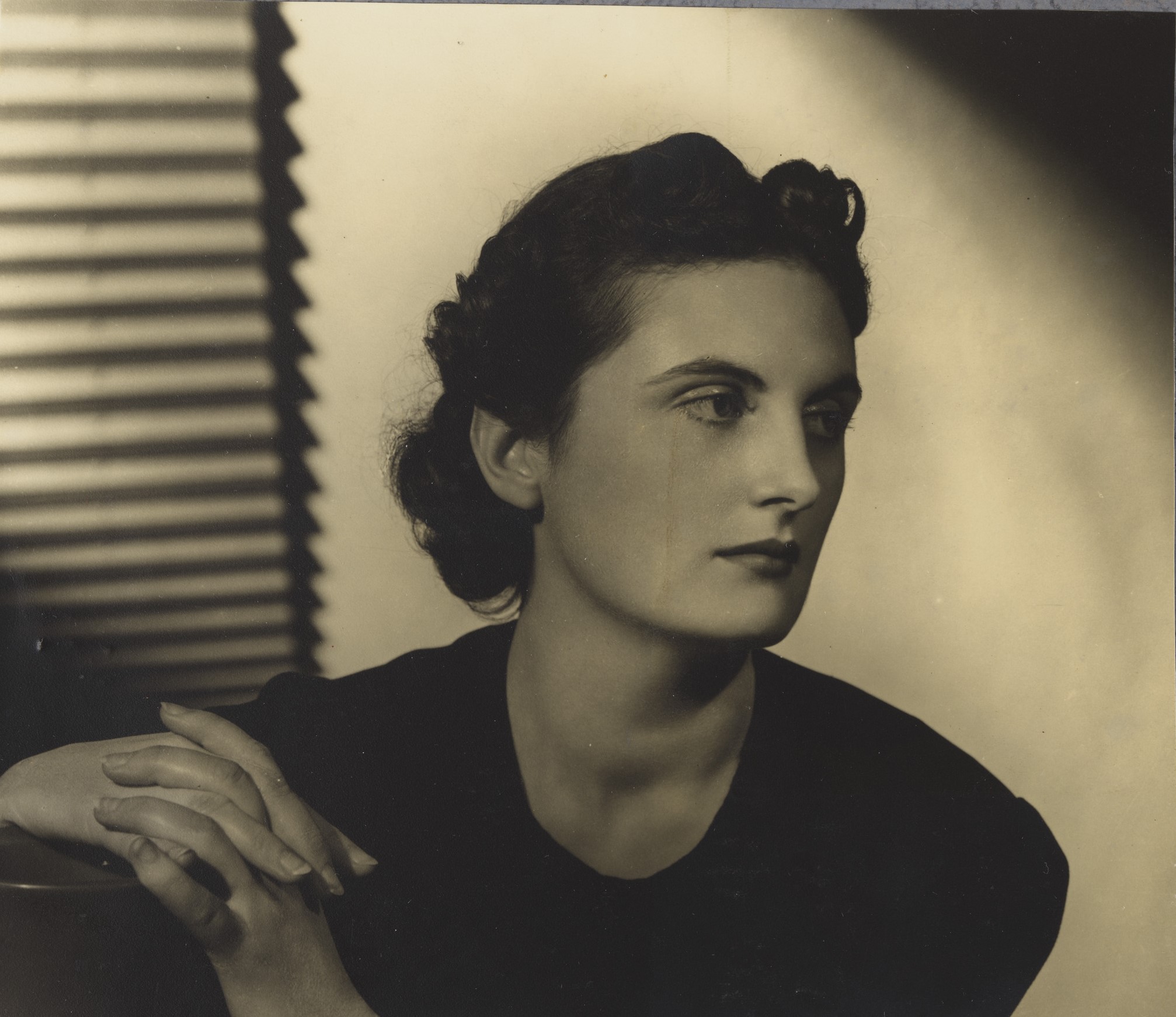
Elizabeth Marie Cotter - photographed by Damien Parer circa 1938 at Max's Studio in Bond street. Item: c27111_0009_c, courtesy State Library of NSW
In late 1938 Parer directed the photography of the short film, This Place Australia, which depicted (in two parts) poems by Henry Lawson and Banjo Paterson. Although the film's camera-work revealed the influence of the cinematographers Tasman and Arthur Higgins and Errol Hind, Parer was at his most original and impressive when adapting the styles of Australian still-photographers to motion pictures: Dupain's cityscapes were models for his sequences showing Sydney, and the pictorialists' use of the Australian light in landscape compositions influenced the way he filmed the Blue Mountains. [6.]
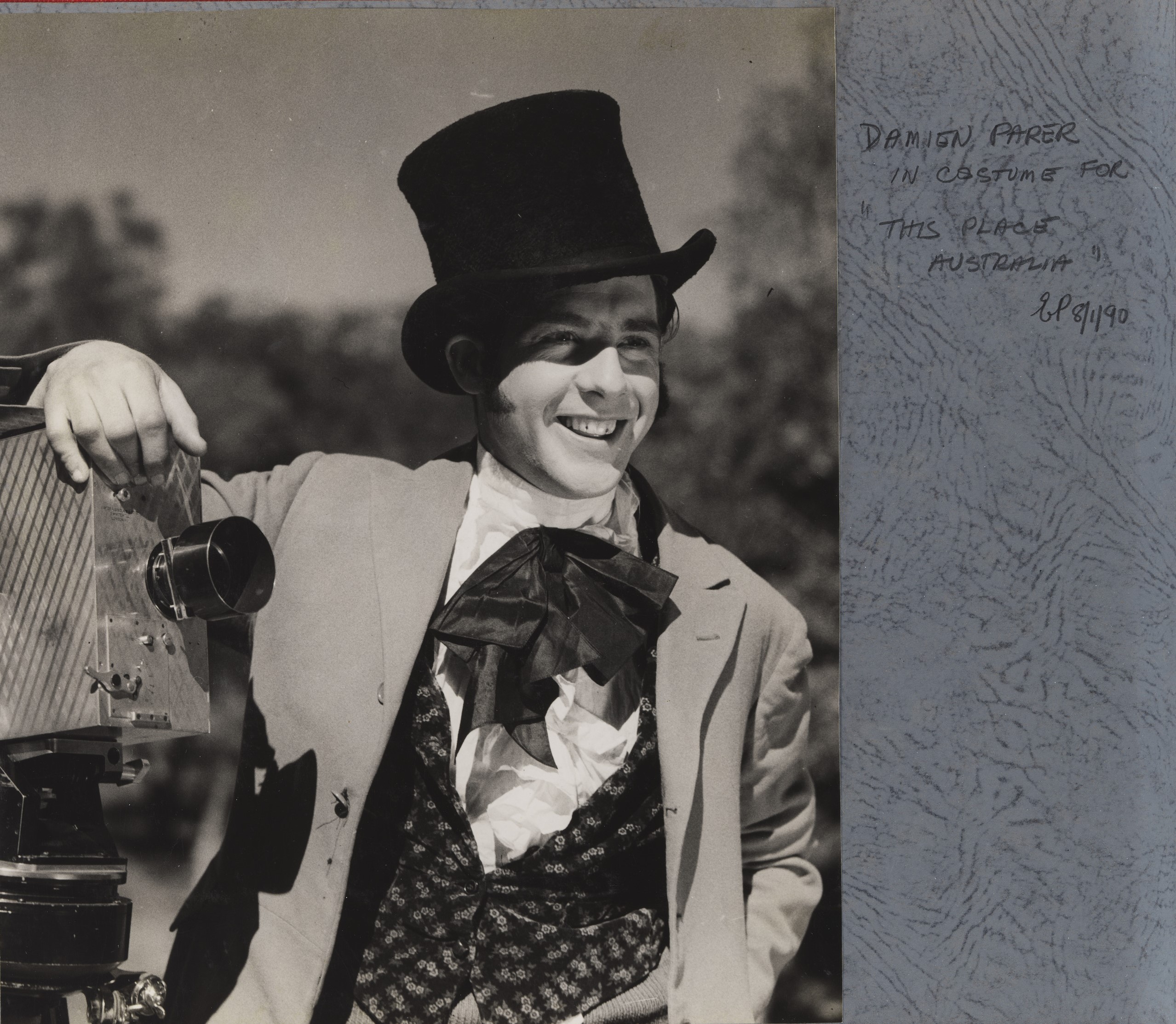
Above and below from: 'Album of photographs which include portraits of Parer as a boy; his wedding to Elizabeth Marie Cotter 23rd March 1944 and unofficial war photographs. Numerous portraits of Damien Parer', courtesy State Library of NSW. Below: Parer at the camera with Stan Tolhurst and George Hughes shooting This Place Australia. Caption from McDonald, N. Damien Parer's War, 2004, p.37
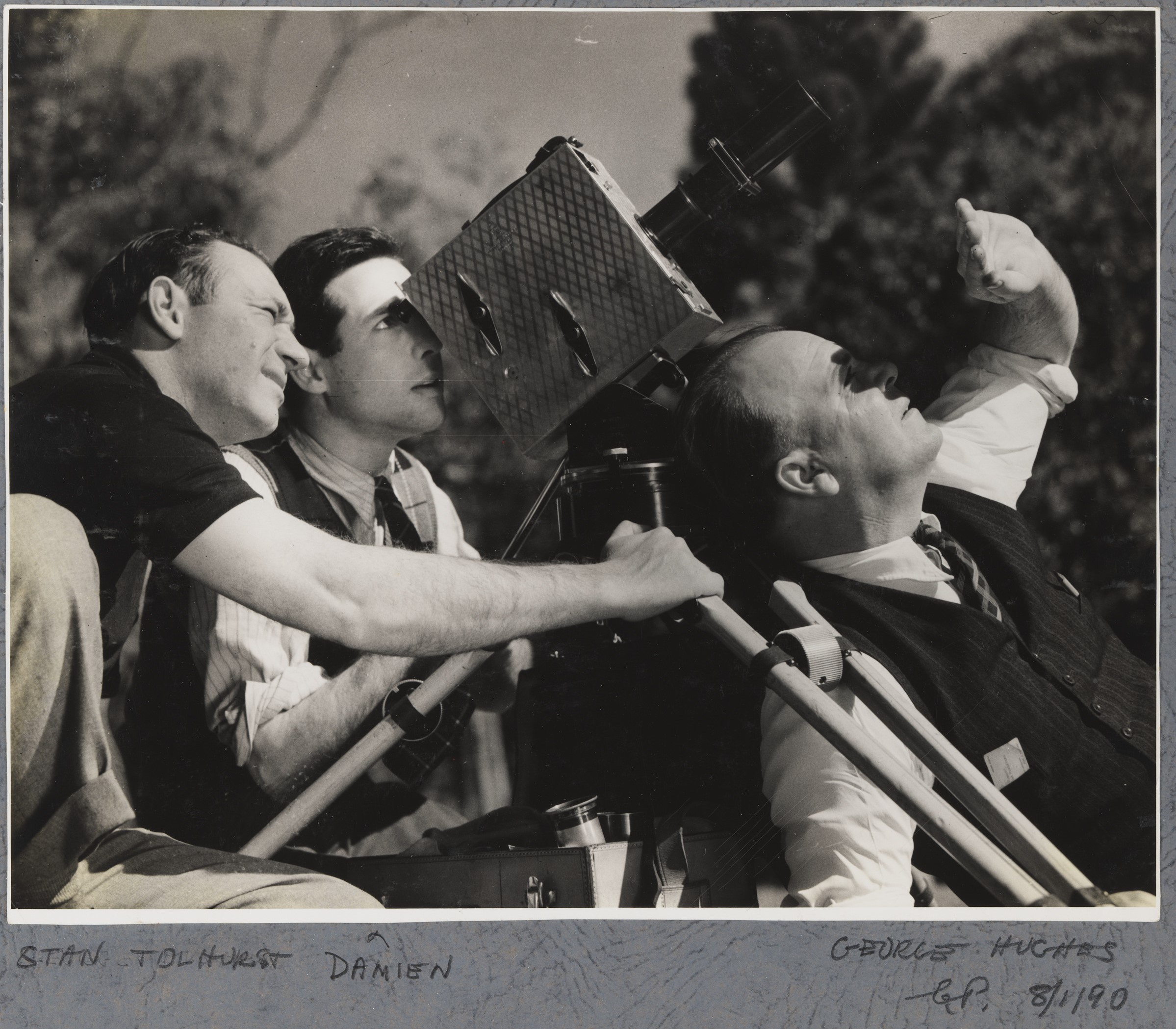
In 1939 Damien was appointed to the staff of the cinema and photographic branch of the Commerce Department of the Commonwealth Government. And then another telegram changed the direction of his life. He received it on 30 August 1939 at the “Oriana Hotel”, McLeay Street, Potts Point, Sydney:
Would you be prepared accept position cameraman same basis as previously advertised and enumerated my letter eight July last if so will have pleasure recommending early appointment, Maplestone Cinema branch Victoria Barracks.
So he moved to St Kilda Army Barracks and worked on Army Training films.
War Photographer and filmmaker; Australia's first Academy Award
By World War II, Parer was experienced at photography and motion pictures, and was appointed as official movie photographer to the Australian Imperial Force (AIF) in August 1940.
Max Dupain recalled:
We all followed his career as closely as possible during the fragmented years of the forties which, ironically, were the real beginning and ending of his career as a motion picture photographer. I remember returning late one night from a holiday on the South Coast and making my first port of call the studios in Bond Street and being greeted by Damien in battle dress. I was shocked by the suddenness of it all and shocked again to realise that we would be losing him from Australia.
“I’m going to the bloody war”, he laughed and accompanied the comment with one of his loud and famous belches! I think we drank several beers to celebrate and there was nobody on earth like Damien after a few beers. He became hilarious and forthright with laughable bombs coupled with amazing outspokenness. He was terrific company. [3]
His first war footage was taken on HMAS Sydney after it had sunk the Italian cruiser Bartolomeo Colleoni. Soon afterwards, he was aboard HMS Ladybird while it was bombarding the sea port of Bardia in Libya. His first experience at close quarters was during a troop advance at Derna.
Parer filmed in Greece and in Syria, covering the action from aircraft, the deck of a ship and on the ground with the infantry. After Syria he travelled to Tobruk once again on the Ladybird in August 1941 before covering the fighting in the Western Desert.
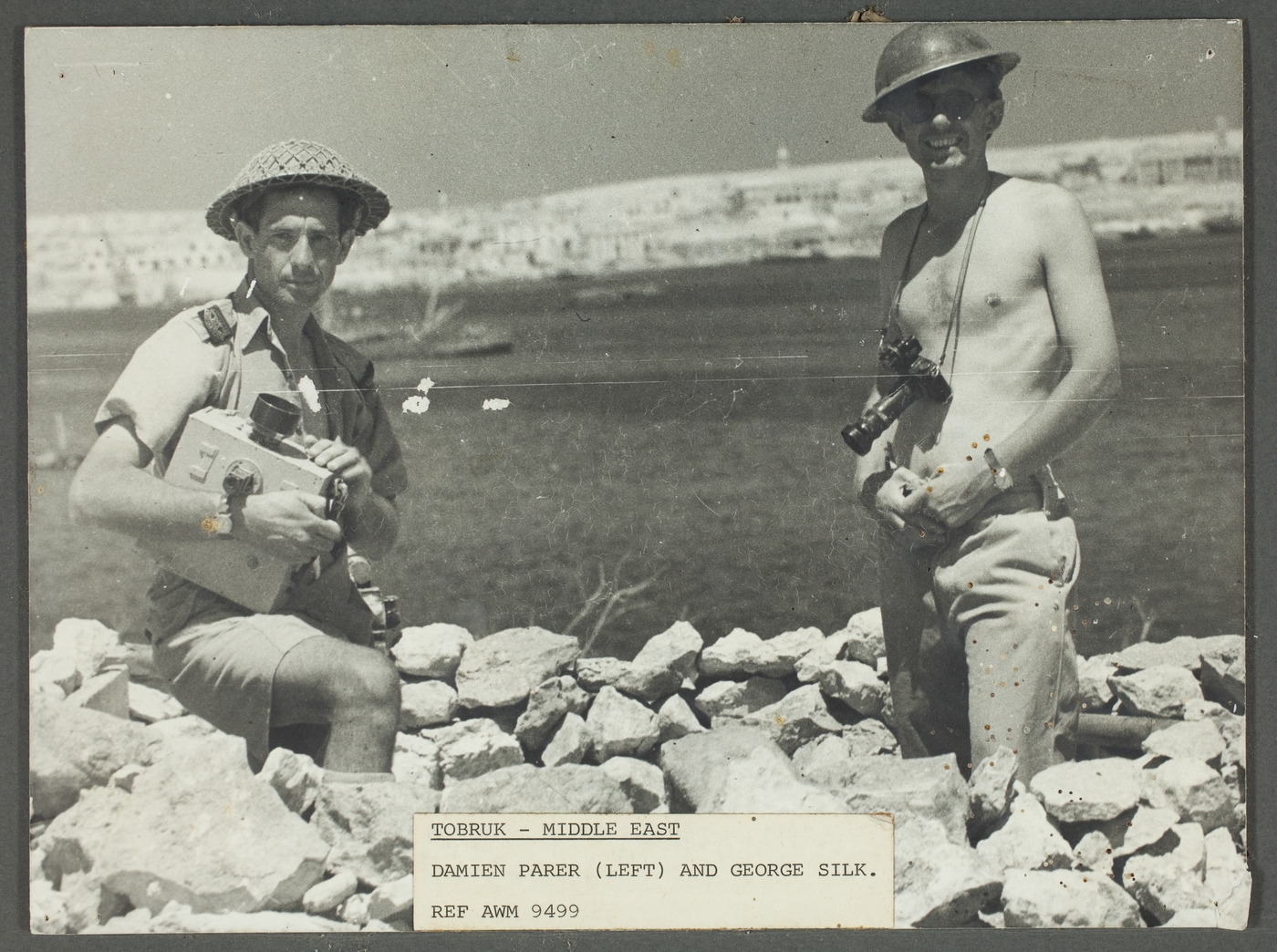
Damien Parer and George Silk [with cameras], Tobruk [August 1941. Dated and captioned in AWM Collection Database: ID No: 009499. 1941-08. TOBRUK. DAMIEN PARER AND A.G. SILK IN "HIDE OUT" ON EDGE OF TOBRUK HARBOUR WAITING FOR AIR RAID. (NEGATIVE BY G. SILK).] Item: a9575023h, courtesy Mitchell Library, State Library of New South Wales
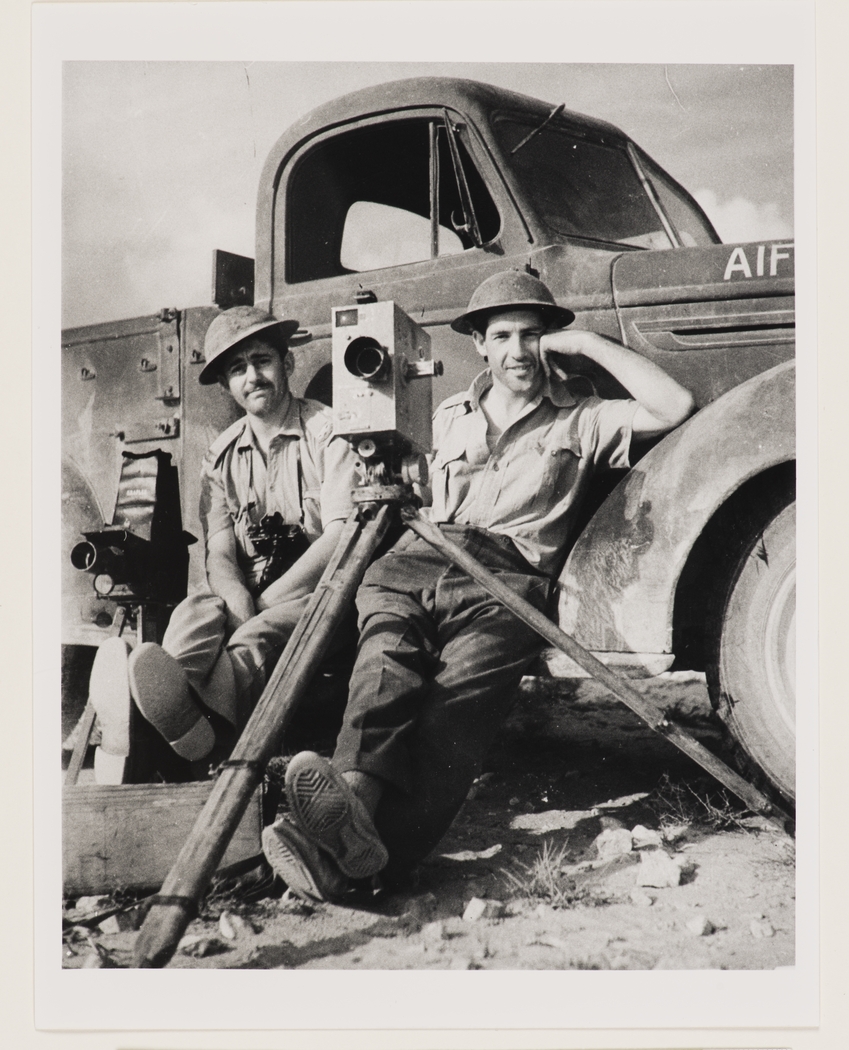
Damien Parer and friend; 'In the Western Desert - we were photographing 3 Squadron of the RAAF'; Description on verso. Item: a9793001h, courtesy Mitchell Library, State Library of New South Wales
By mid-1942 Parer was in New Guinea ready to cover the fighting against the Japanese. Together with war correspondent Osmar White, he undertook an arduous journey by schooner, launch and on foot from Port Moresby to Wau via Yule Island, Terapo and Kudjiru, in order to document the efforts of the meagre forces then fighting on the northern coast of Papua New Guinea.
During this phase of the war, he filmed some of his most famous sequences, some at Salamaua and, most notably, those used in Kokoda Front Line!. This documentary won its producer, Ken G. Hall, an Academy Award for documentary film-making and was Australia's first academy Award.
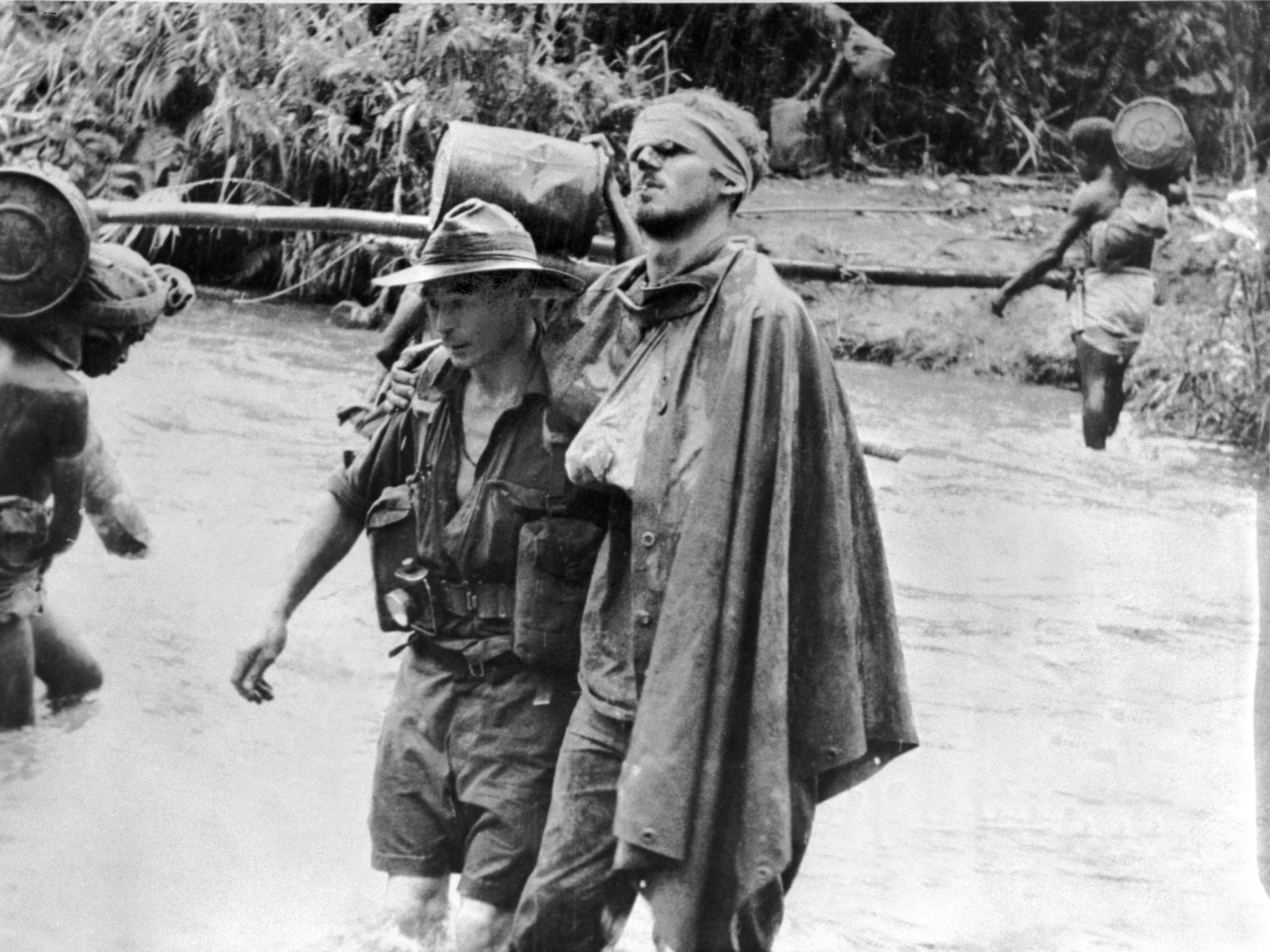
A Damien Parer image that has become iconic of the New Guinea campaign during World War II. Image Credit: Australian war Memorial
.jpg?timestamp=1713143644578)
Damien Parer with cine camera shooting film from an open plane, ca.1942.
Kokoda Front Line!, a special full-length edition of the Australian Cinesound Review newsreel, first screened in Australia on 18 September 1942. It was the first time that local audiences saw the gruelling conditions under which the campaign in the Pacific was being fought, in a war that had seemed until that point, 'a million miles away’.
The State Library of NSW said in a biography of Damien:
'Parer’s achievement in creating some of our most memorable images of the Second World War was all the more remarkable as the cinematographer couldn’t see any of the pictures he was taking. There were no facilities for developing film on the spot in the jungle. All of Parer’s footage was sent back to laboratories in Sydney where it was processed and cut together using his shooting notes as a guide.
The impact of Kokoda Front Line! was further enhanced by the extra authenticity created by Parer’s oration to this film, recorded just weeks after his return from the Owen Stanley track. With Kokoda still very much on his mind, and bearing visible traces of pain and sympathy on his face, Parer convincingly and urgently reminded viewers that that the war was ‘just outside our door’.'
Film still: Damien Parer addressing the audience, 'Kokoda Front Line', 1942. Item c27111_0001_c.jpg
The Oscar was presented by David O. Selznick (producer of Gone with the Wind) and accepted by Australian director John Farrow on behalf of the Australian News Information Bureau. Kokoda Front Line! was one of four recipients of the inaugural Oscar for best documentary short in 1942, sharing honours with Battle Of Midway, Prelude To War and Moscow Strikes Back. Writing to Ken G. Hall to offer his congratulations in June 1943, Selznick quoted the words which would appear on the plaque commemorating the award:
‘To Kokoda Front Line!
For its effectiveness in portraying, simply yet forcibly, the scene of war in New Guinea, and for its moving presentation of the bravery and fortitude of our Australian comrades-in-arms.
Kokoda Front Line! became the first Australian film nominated for an Academy Award and Australia’s first ever Oscar. This was was awarded to Ken G Hall (1901–1994), chief director of Cinesound Review, at the 1942 Awards ceremony held in Hollywood on 4 March 1943. It is also believed to be the only newsreel to ever be awarded an Oscar.
A plaster-cast replica of the famous statue was sent out to Sydney for presentation to Hall on 14 December 1943, as metal was scarce during the war. This was swapped for the gold-plated copper alloy version in 1945, and later donated by Hall to the National Film and Sound Archives (NFSA) dedicated to the memory of Damien Parer – ‘to his bravery, skill and endurance … He made it possible.’
Damien Parer shot footage during the Battle of Guam that won him a posthumous Headliner Award from the American Journalists' Association.
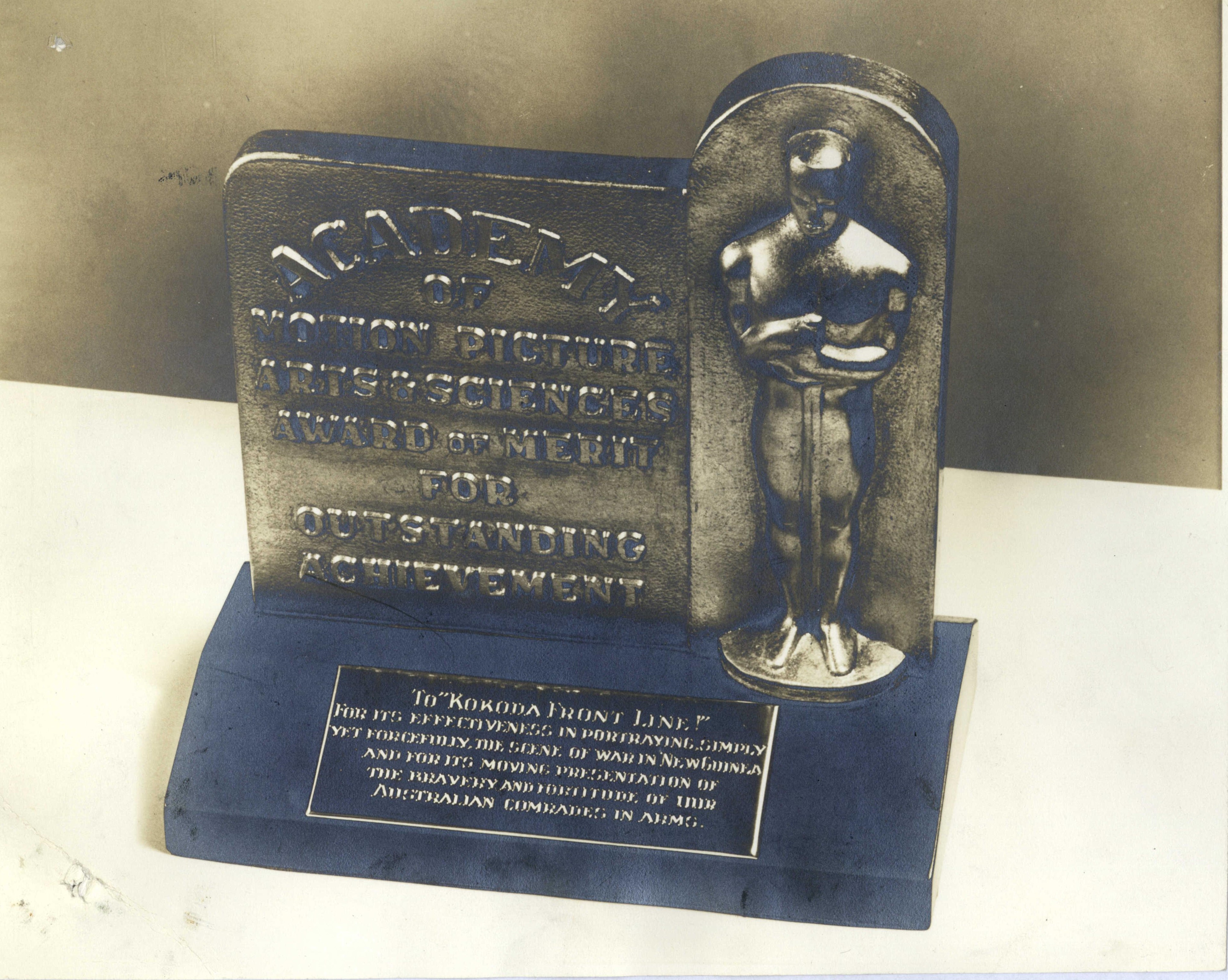
In October 1942 he was also featured in a radio interview which then was published in a magazine - which had been preceded by another in September 1942 - in fact, he was articulate as much as a great photographer who had 'the eye' a great filmmaker and photographer will have:
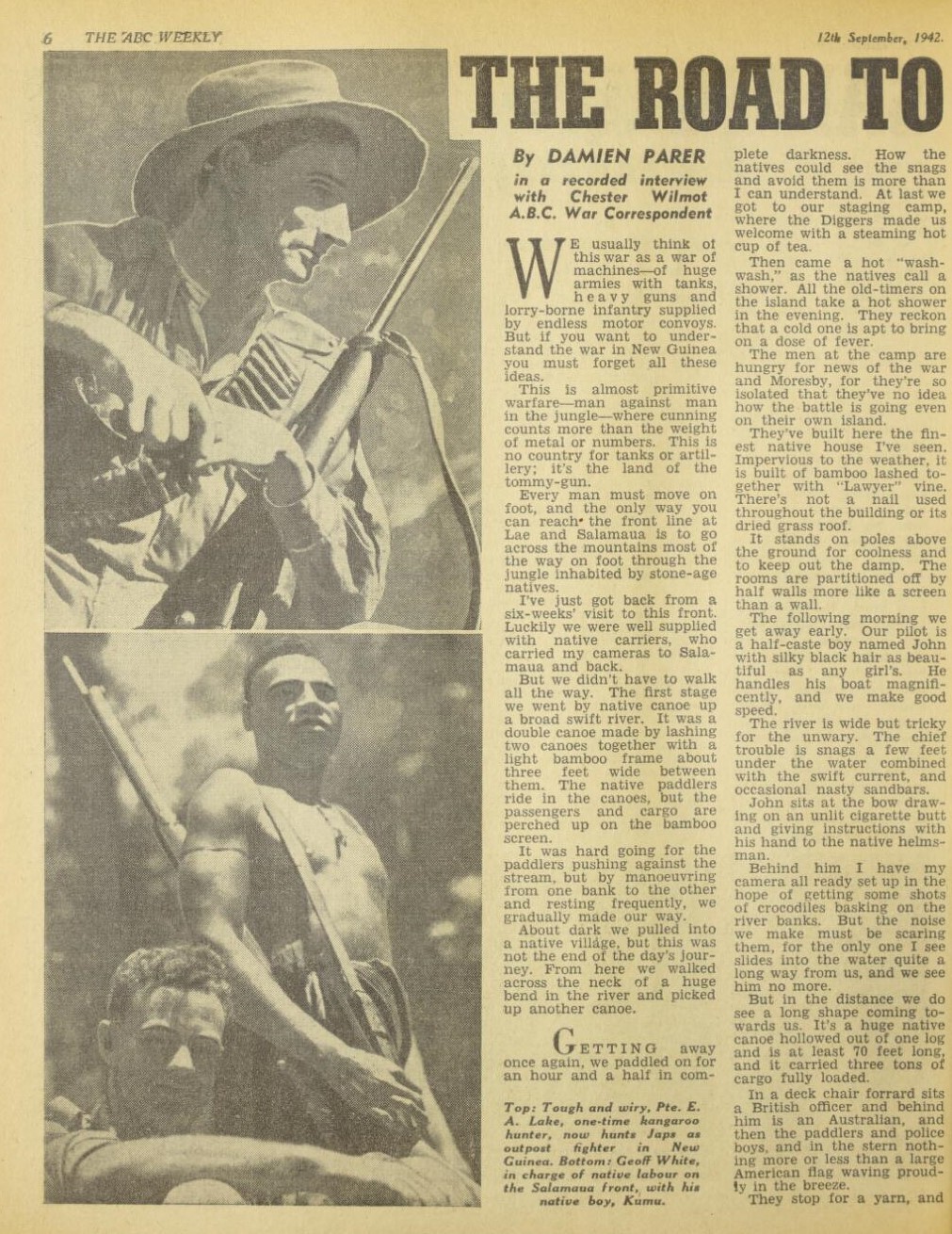
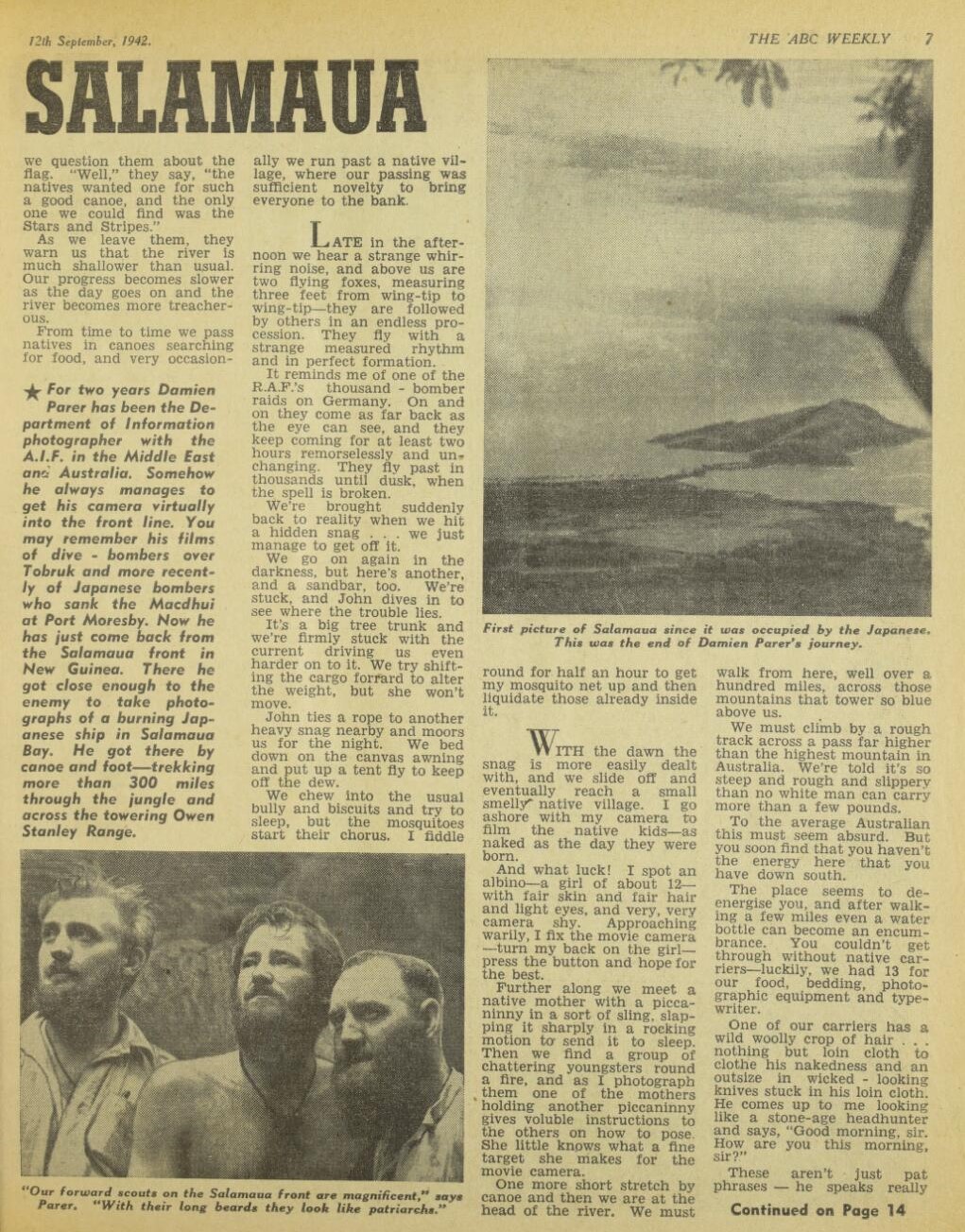
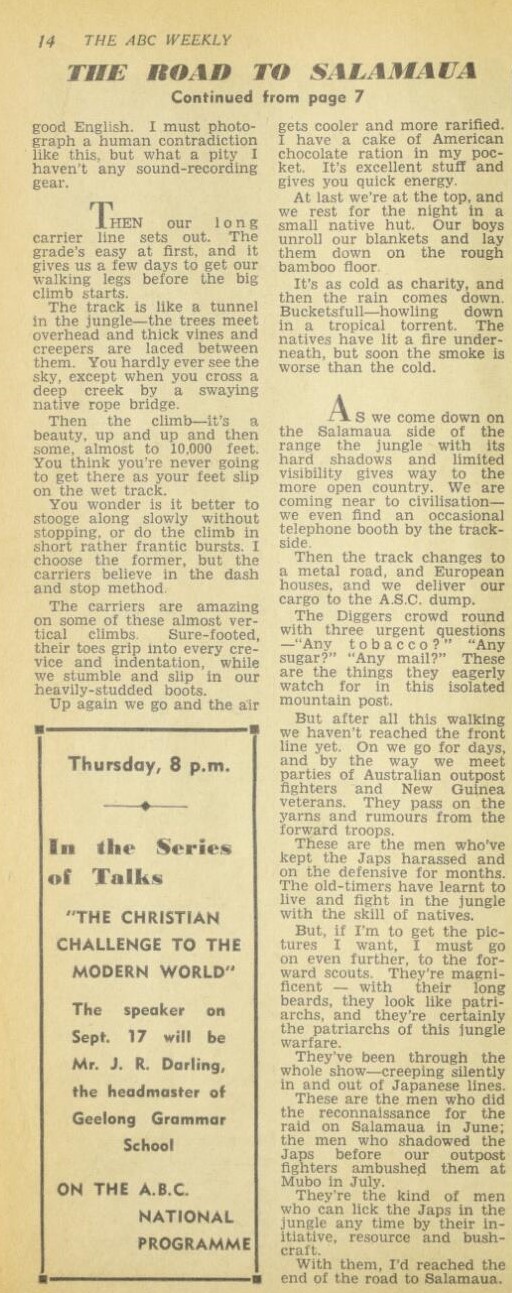
Australian Broadcasting Commission. (Vol. 4 No. 37 (12 September 1942) ). THE ROAD TO SALAMAUA, ABC weekly Retrieved from http://nla.gov.au/nla.obj-1329221802


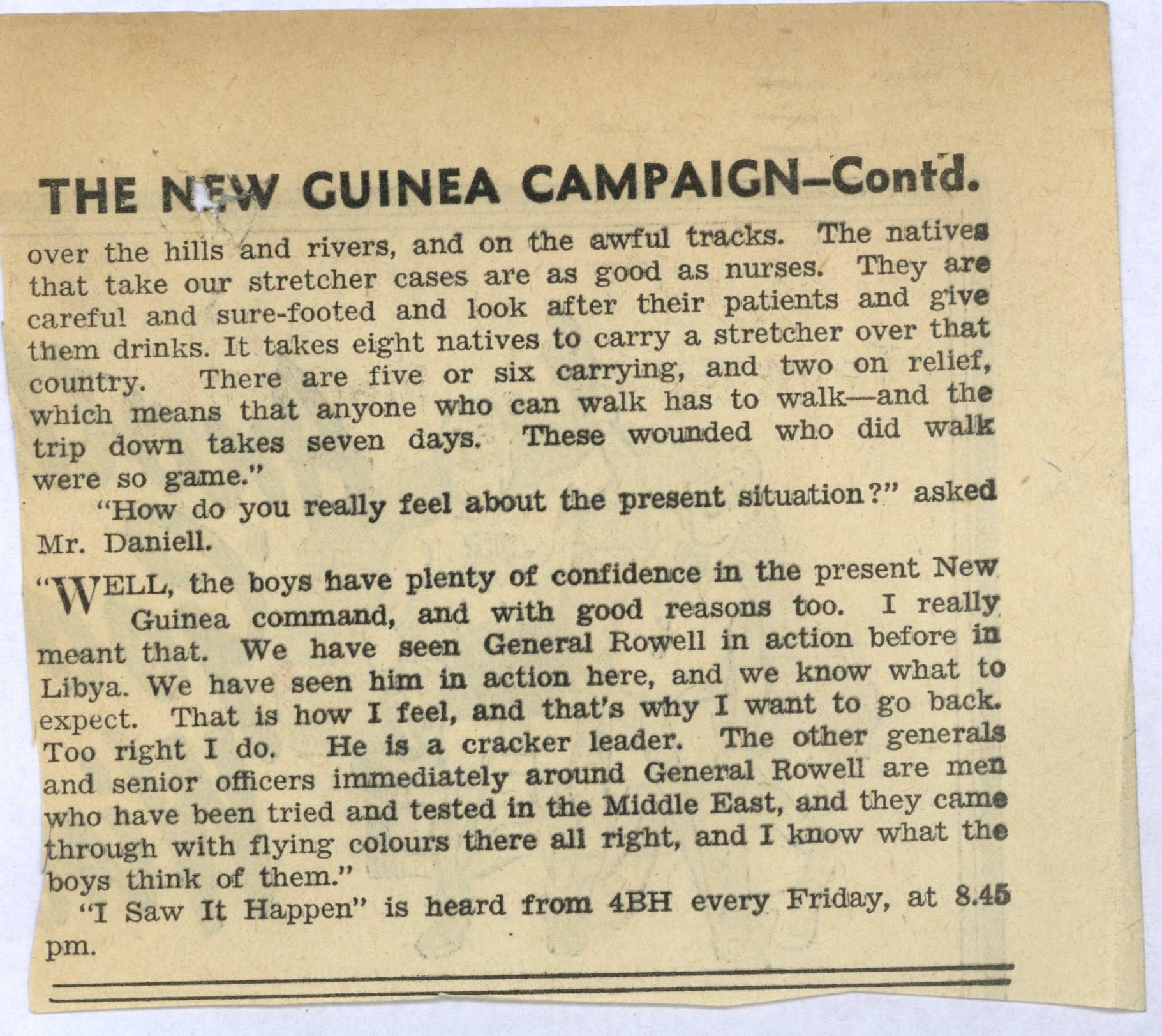
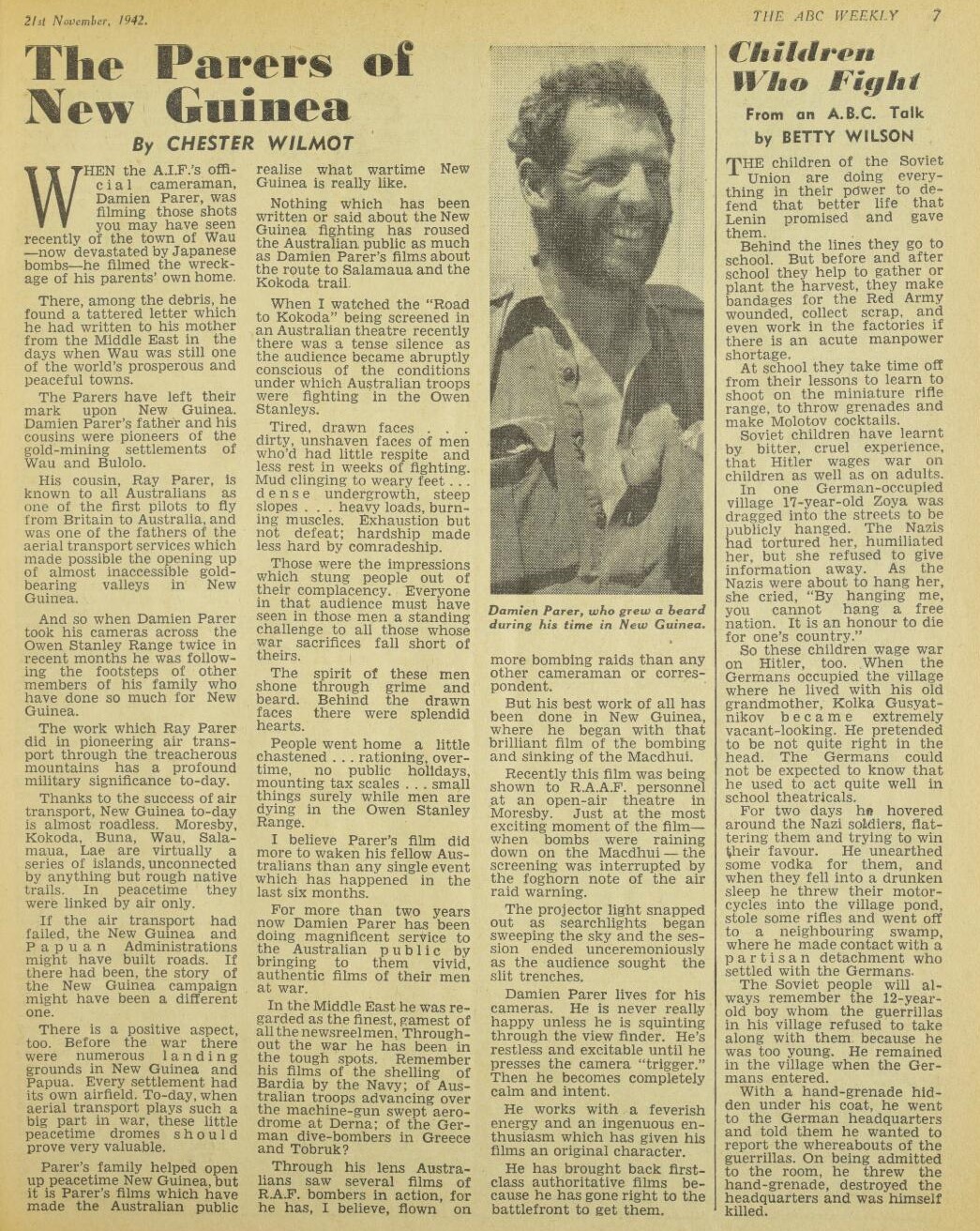
Australian Broadcasting Commission. (Vol. 4 No. 47 (21 November 1942). The Parers of New Guinea, ABC weekly Retrieved from http://nla.gov.au/nla.obj-1329715521
Another from November 1942 under 'Natives' by the man himself;
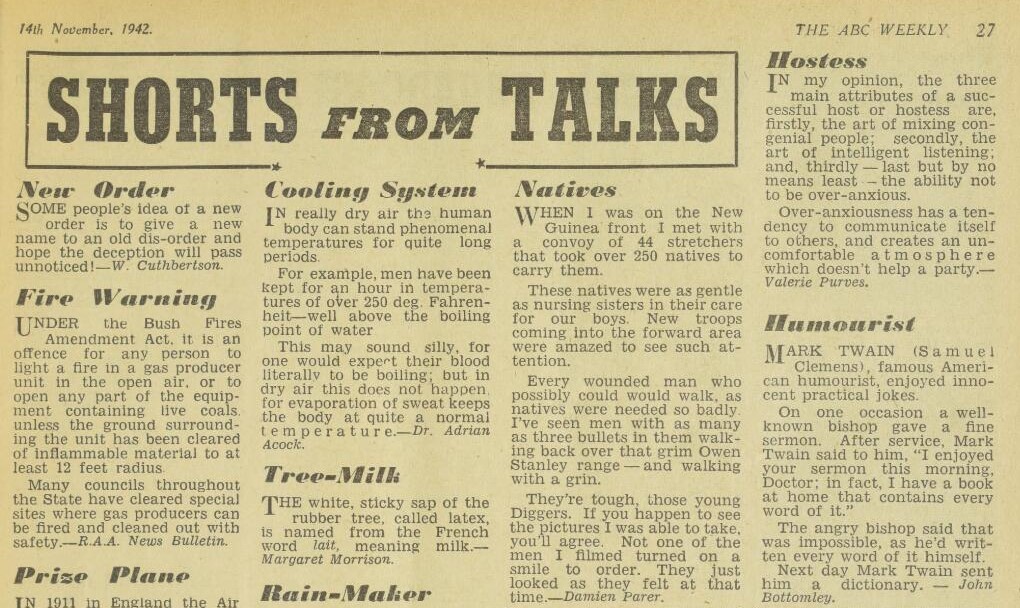
Men of Timor: Sparrow Force
Men of Timor is a 1943 short documentary propaganda film about the guerrilla warfare activities of Sparrow Force on Timor Island during World War II.
The film opens with a map of the Timor Sea area, showing Timor Island, then Japanese occupied Dutch Timor and Portuguese Timor (East Timor), in relation to the coast of the Northern Territory in northern Australia. It briefly explains the circumstances of the Australian troops left behind, who did not surrender but carried on a guerrilla war against the Japanese.
After some very difficult forays behind enemy lines to capture equipment for radio, they manage to contact the Australian military in the city of Darwin across the Timor Sea. Wary of a possible Japanese trick, the military asked the Sparrow Force men what the first name of a wife of a particular sergeant was. When the correct answer, Joan, was returned, the Australian military starts to airlift supplies to the Allied guerrillas and their Timorese allies.
Damien Parer, British journalist Dixon-Brown and ABC war correspondent Bill Marien travelled to Timor in November 1942 to report on the conflict. The Australian soldiers delayed an attack until Parer's arrival so he could film it. Embarked from Darwin in HMAS Castlemaine, a corvette for Betano on 5 November 1942 and returned embarking at Belano in Timor for Darwin, Australia on 16 November 1942.
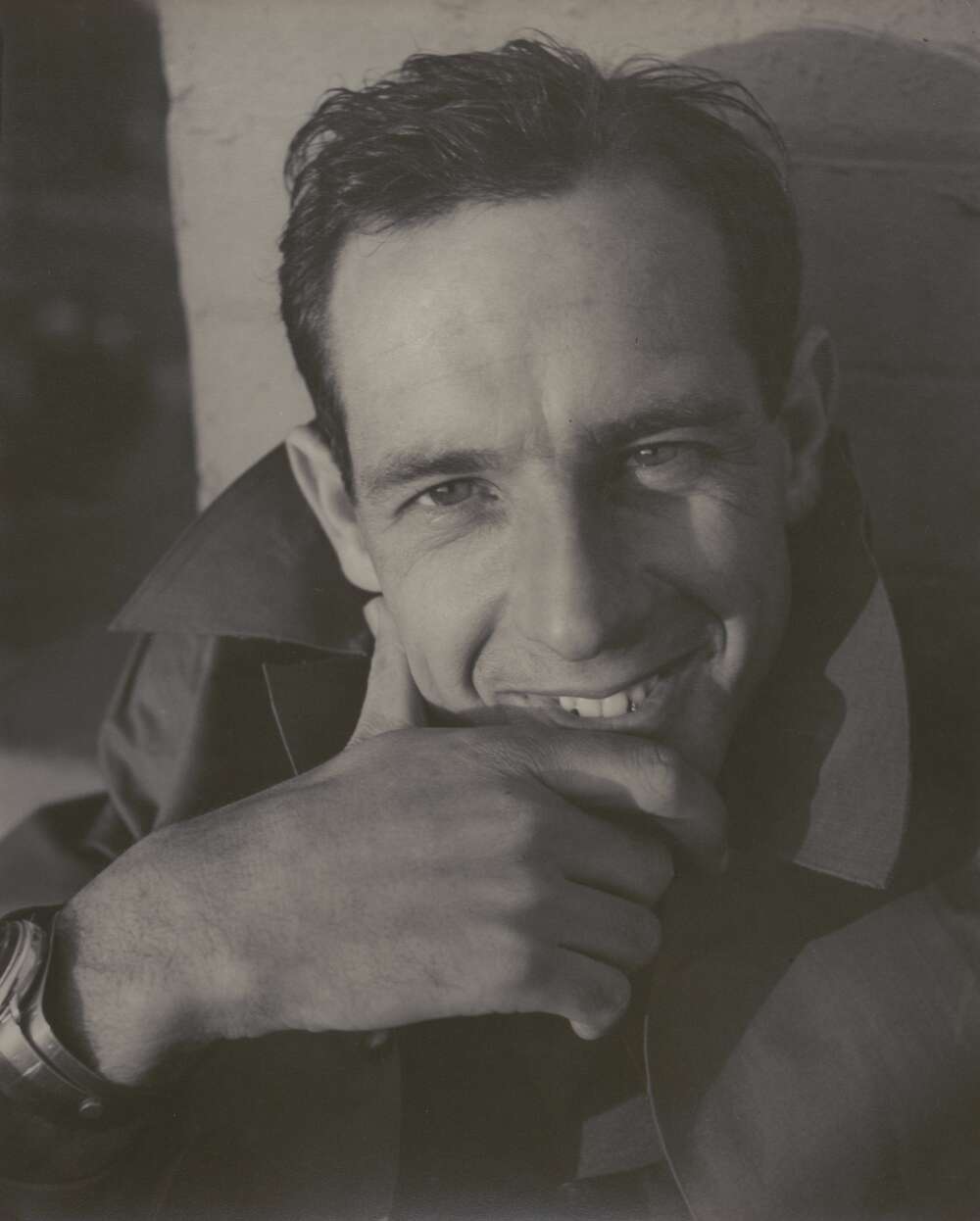
Dupain, Max. ([1942?]). Portrait of Damien Parer in the early 1940s Retrieved from http://nla.gov.au/nla.obj-136229231 - 1942 ?
His report:
Japs Fear Invasion Of Timor: Commandos' Toll
By DAMIEN PARER, Cinematographer of the Dept. of information, who recently visited Portuguese Timor.
Invasion of Timor by Allied forces is a possibility that considerably worries the Japanese.
THEY have lost so many of their own men in attempts to round up Australian Commandos that they are now using natives for this dangerous task. It has been reliably estimated that we have killed about 100 Japanese for every one of our own men killed in action in this cunning, stealthy warfare of the mountains. Relations of the Commando force with the natives embrace two extremes. There are natives employed by the Japanese, armed with rifles, and encouraged to hunt down our men and to intimidate natives friendly to the Australians. On the other hand, we would hardly have been able to exist without the help and kindness of the mountain natives, who are loyal to the Portuguese Administration, and who have formed a strong attachment to the Australians.
One of the signalmen who in North Australia first contacted by radio the Australian "lost legion" holding out in Timor here tells his story: —
That night in the Northern Territory, another signalman and I were on duty. The "cans" were pressed to our ears, straining to discern the faint calls of some unknown station which was apparently trying to contact us.
"Blank (a certain call sign) calling stations on -- (an other sign)." "Blank calling --" "I wonder who it can be?" I said, "Blank have been off the air for a month. "This sounds fishy. Go over and get Lieutenant "
"Capt Parker Calling" The lieutenant hurried over and started hurling questions at me. "Right; now ask him who he is and where he is operating from. Then if he answers that get him to identify himself." Out went the message, and we waited, tensed. Back it came slowly, deliberately, carefully: "Blank calling Dash. This is Captain Parker calling from Timor."
The caller was asked for means of identification. While we were waiting, a corporal, who had accompanied the lieutenant, spoke up: "I seem to remember a Captain Parker. Wasn't he working a station earlier in the year? ... In fact, I'm sure of it. Hold him for a while. I'll go and wake up Andy. He was working on that station at the time." The corporal came back with Andy.
"I knew George well," he said. "We-joined up together, and I know his family intimately."
Then we went to work. "What is your wife's name?" "Joan." By the end of this cross-examination the lieutenant was satisfied that everything was OK. Then we received a message to take down code.
"Bushranging Life"
Life as a Timor Commando is "not bad if you keep the right outlook."
" This is the way Dr. Dunkley, son of Fremantle's Mayoress, Mrs. P. E. Gibson, feels about it. In a letter from Timor some weeks ago, Dr. Dunkley said: "We are approaching nearer and nearer to the bushranging type of existence." For his services in Timor, Dr. Dunkley received a letter of commendation from General Sir Thomas Blamey.

Bearded Australian guerrillas in Timor take turns at sampling the native alcoholic drink, "Tuaka." In possession of the bamboo-pole containing the liquor is Signaller G. Gennedy, of Newport.
.jpg?timestamp=1713157718535)
Signaller Ernie Gregg, Australian guerrilla fighter in Timor, wears a cane hat woven by natives. Dept. of Information pictures. Japs Fear Invasion Of Timor: Commandos' Toll (1943, January 3). The Sun (Sydney, NSW : 1910 - 1954), p. 6. Retrieved from http://nla.gov.au/nla.news-article231743102
Another on his work when filming the men who were 'Sparrow Force':
SEEKING TRUTH WITH A MOVIE CAMERA
Damien Parer; An Idealist
By CRAYTON BURNS
 Australia will need Damien Parer, Department of Information cinematographer and his colleagues after the war to build an Australian film industry.
Australia will need Damien Parer, Department of Information cinematographer and his colleagues after the war to build an Australian film industry.
All he has seen this 3 years in every theatre of war has not hardened him or made him cynical. He is still a visionary and an idealist, and still, at moments, very boyish.
We saw in his Kokoda film some of the things which brought the marks of pain and sympathy into his face and into his voice when he made the peroration to his film weeks after he went up the Owen Stanley track with his camera. That Kokoda film, I have reason to know, contributed largely to the success of the Austerity Loan. It was stark and genuine. At last, the Australian public felt, here was a sample of the truth they had been seeking, and truth called for devotion, possibly sacrifice.
A colleague recently returned from a remote Australian battle station where the greatest enemies are monotony and tropical languor, told me that the screening for the troops there of that Kokoda film did more than anything else to boost the spirit and morale of the troops. What had they to grumble about if the boys on the Kokoda track could keep cheerful?
CRITIC OF OWN WORK
Now I have had the privilege of meeting my young friend Damien again and of sitting with him in a newsreel theatre while his film of the Timor commandos was running. He was not there for any personal gratification, but to see how the respective film editors had treated his film and, above all, to see what technical errors he^ himself had made.
He found a lot in his own work to criticise. Most of all he regretted that he had not had the luck to get a Japanese dead or alive, into the camera lens. It was not his fault. He was with the outpost party on the raid; but the Japanese were too quick. This time they did not stand and fight; they got away, leaving the bad natives to their fate, He wished he could have done the film again; could have had more time; could have been permitted to go out in a bomber on reconnaissance over Timor to get more of those "long shots." ("Long shots" are camera-men's jargon for panoramic views, as distinct from "close ups.") Those long shots, he admitted, were good. They gave some idea of the terrain over which those Timor commandos are harrying the Japanese. The pony trekking scenes gave at a glimpse what volumes of words could not convey about guerilla war in those mountain fastnesses.
These commandos are leading sacrificial lives. Death, or at least pain and disablement, may be their lot at any turn of the road. The Japanese hate them with a burning, unforgiving hatred. They have caused the Japanese Army to lose face-a handful of men holding up thousands, raiding the Japanese Army in Timor in its own head-quarters, stealing weapons and am-munition, and radio parts. Worst of all, they refuse to surrender when politely invited to do so. They won't admit they are beaten when the Imperial Nippon Army says they are.
TOOK HIS CHANCE
Parer went to Timor in an endeavour to make for Australia today, and for historical record, a short pictorial report that would do jus-tice to those commandos. They agreed to his coming, but he must take his chance with the rest, they said, and be ready to get himself out of trouble should anything go wrong. He and 2 war correspondents after hard going reached headquarters of what the Army, by ironical jest, calls the "Sparrow Force."
Parer followed his usual practice; he did not produce his camera until he had found out as much as possible of the facts. He has an almost fanatical devotion to the truth, especially in pictorial record. He reckons that in assignments of this kind he is sent to see and record things that must happen, but will not recur. They will all happen quickly, and some unexpectedly. He must know in his own mind what he wants to do. The pictures must be recorded in his own imagination before they are put on the film. The camera is but an extension of the. photographer's personality.
The cinematographer and the re-porter are both war correspondents, and accredited as such by the Army. Only the technique by which they make their reports is different. The reporter gives it in words through a typewriter; the cinematographer puts it on film - there, on the instant. If he misses, the chance is lost and cannot be recovered. That is why he must know exactly what he wants to do when the instant arrives, and why he must train him-self to act automatically, if taken unawares, to do the right thing which means getting the picture.
That is what Damien Parer has done in the Timor film. He is not satisfied with it; does not think it worthy of the subject, but, as an objective observer, I still say it is good. SEEKING TRUTH WITH A MOVIE CAMERA (1943, January 4). The Argus (Melbourne, Vic. : 1848 - 1957), p. 2. Retrieved from http://nla.gov.au/nla.news-article11343100
He went back to New Guinea to produce the “Assault on Salamaua” which he himself always considered better than the film he shot for the Kokoda Trail. In an RAAF Beaufighter his camera gave us the story of the “Bismark Sea Battle” in which 22 Japanese ships were sunk.

Still frame from The Bismark Convoy Smashed (1943). Flight Lieutenant Ron "Torchy" Uren of No. 30 Squadron RAAF takes a drink from his water canteen while in the cockpit of his Bristol Beaufighter during the Battle of the Bismarck Sea. Parer flew with him to record attacks against Japanese ships
Records and anecdotes state over and over Damien was 'fearless'. Another Pittwater photographer who also served as a War Photographer only in WWI, Frank Hurley wrote to Parer in 1943, ‘Take a survivor’s advice. They only say, “Yes, a gallant chap” – great pity. So don’t be too brave. The coves don’t appreciate it.” [5.]
However, with one eye on the future and marriage, he found it impossible to continue as a war photographer on what was paid at that time and with an Academy Award under his belt, he had begun to make his mark in his chosen field. His War Record documents, held by the National Archives of Australia, show some misunderstandings took place and that he lost personal equipment during some of his work which he requested by replaced, and this was refused. Another letter shows some of his expenses should have been met but were never submitted by him for reimbursement.
Damien's War Diary states:
FRIDAY 21ST MAY 1943
Saw Shan Benson for a few minutes today expected him to tea but it rained like beggary and he didn’t come. He is camped out in the hills and to see through the infantry in their eternal uncomforted gave me the old feeling of the wonder of it all, also gave me some new impetus to get on with my new infantry film.
Last night a letter arrived from Jack Allen in answer to my memo on living expenses. The Office refused to increase my expenses, I decided to get straight down to the job of putting the matter in the hands of the AJA. I don’t think that the office realises that I’ll carry this thing to a finish. While in Sydney I told Haws that I couldn’t continue to work with this expense allowance so if the AJ will not handle, or do anything about it I’ll give the Office my necessary 3 months notice. I wrote to George to tell him of this today as it contradicted what I said to him in my letter yesterday about not resigning.
Tonight went along to the 5th Airforce US. They rig up a 16 mil show in the mess much better than the outdoor as it is the case in other areas in Moresby. The actual quality is really good for 16mm. Sound not as good as picture. Main film was Warner’s Yankee Doodle Dandy. Cagney mainly, Joan Leslie, Walter Houston etc. Interesting show play, weaving and sentimental-ness to the highest degree. The boys liked it.
On Thursday, Brown and myself went to the 29th AGH to do some CCMY pictures of the nurses – Matron Marshall is very pleasant and appears efficient, had the usual beggaring about that happens when a photographer wants to do some shots of nurses in an otherwise strictly male area. The collective reputation of the girls must be doubly guarded a wealth of scandal can blow up like wild fire into a howling gale, so they are naturally reticent. I remember very clearly the time when I first met Matron Sage to AGH as her ship pulled into the Middle East. I met her she asked me if I had taken shots of the nurses 1. at a cocktail party. 2. On the beach mucking around. I said yes and she told me off in a big way. I felt like crawling away and dying.
WEDNESDAY 26TH MAY 1943
Told Sherry that Bob Curtis has shown me that it was far better to do things through the AJA. Went to Mass and prayed for guidance. Sherry was annoyed about my weak and changing attitude, and refused to do any typing for me so I copied my memo and the departments answer out in handwriting. While doing it I thought and said an occasional prayer, walked up and down and decided to send in my resignation. I compared this problem to the one I had last August, when the department kept sending me urgent signals to come South, and I wanted to go on the Kokoda Trail. I quite made up my mind finally to go South and Ches Wilmot with his forceful personality simply talked me out of it. Without Chester there would have been no Kokoda film. Without Charlie Maddan getting my film supplies to me in some miraculous aerial way too, there’d have been no film. How much do we depend on a small twist of fate or men for our success or failure.
Well the resignations gone in and I feel better already, they can go to hell. I date this the 25th May, that means my release on 25th August.
I wrote to Ken Hall, Allan Anderson and Geo Silk, Phonse Parer and Ron Williams. Yesterday a signal came through for me to pass to M.E.A. to see Clobby to get instructions on Catalina story. I won’t have time to call and see Cyril and Bern now. Young Silk got an excellent write up in the Argus, his position is getting strong and now that I’ll be joining him it should be much better. I looked up at the sky and a liberator in full view passed by batting over. I thought how good it felt about having resigned my job and everything, and an after thought struck me that there’d be plenty of times that I’d regret having made this break.
The Governor-General, Lord Gowrie, arrived today. His plane got in at 25 to 6 pm. Light was going and I had another jam in the elmo so I threw out the whole spool. This bloody camera is worrying me, I feel I’ll never take a decent picture with it now.
FRIDAY 28TH MAY, 1943
Letter form Allan Anderson. He’s seen S.P.Ashley and finally been ousted. It is undoubtedly a dirty bureaucratic trick. I’ve decided if DOI wanted to hold me, I will make 3 points.
- Adequate expenses.
- Good possibilities of English trip.
- Revision of Allan’s dismissal.
I wrote and told him today, made my will too. Jim Howard and Sherry witnessed it, everything I have goes to Mum and Dad except my books which go to Ronnie Williams. Captain Joe Woods fixed my elmo lens once more. That dreadful uneven noise was caused by (A) a loose spindle. (B) a loose lever sprocket. (C) a rubbing by the door on the cat take up spool or all three.
Saw form goes at 21 Squadron – not much.
THURSDAY 10TH JUNE 1943
Letter from Haws dated 4 June 1943 accepting my resignation. He also says, “May I take this opportunity of expressing on behalf of the Department of Information appreciation of the excellent services you have rendered in the Middle East and in the South West Pacific areas.” Ye Lord it’s the first time he’s expressed his appreciation for any of my work in writing.
Allan Jones just told me that dear Rocky Mullins has gone. Oh golly, how small are my little troubles beside the heroism of these flyers. Lovable tired looking Rocky. It happened a couple of weeks ago. I never knew anything about it and may his soul rest in peace. His WAG was a fine type of chap with complete confidence in Rocky. Apparently it happened in a search for a missing launch. It wasn’t a strike.
Today I received Martin Barnett’s letter and I made 7 points.
- I am not yet tied to anyone.
- Haws accepts my resignation.
- Ken Hall asks me to reconsider.
- I will if the department accepts my conditions.
- It looks as thought the department will not.
- I am interested in his offer.
- Work on any front preferably England or Middle East.
Have written to Phonse telling him of American offer and that it’s nice and that I’ll give the department until the 17th of June to make up its mind whether they want me or not. Both letters posted today.
In a letter to Shan Benson on writing to the department blocking Silks efforts to get a job with Life says: “Greater hate than this no man hath.”
Looks like something is moving in the South West Pacific. Much guessing is going on in the Wau Merboo area going to advance and take here and Salamaua. Are we going to push out from Milne Bay to Woodlark and the Trobriands?
WEDNESDAY 24TH NOVEMBER, 1943
Australian mail has been held up for some weeks for lack of aeroplane space. Someone even suggested that Garry Cooper and company took the plane with our mail.
Received a letter from M Logan. It was most involved. Worked out at six seventh amount and two sevenths, but things I have discovered from it, I get £30.0.4 while in Australia and £37.16.8 out of Australia. Up to the 20th November, Paramount have given £198.3.4 of my salary.
Malcolm Henry Ellis, an Australian journalist, historian, critic and reviewer with The Bulletin who won praise during World War II for his column, ‘The Service Man’, which appeared under the pseudonym ‘Ek Dum’ stated after a book on him, Frank Legg’s “The Eyes of Damien Parer”, was released:
The third and last phase began in August, 1943, when he felt that he had reached the parting of the ways with the bureaucrats of the Information Department from whom he had experienced nothing but frustration since his return to the Pacific. There was a good deal of behind-the-scenes envy of his performance and of official irritation with his exercise of initiative in disobedience to orders – one instance was responsible for his Kokoda Trail picture. So when he was ordered to go off to Broome (WA), where somebody or other anticipated an entirely improbable Japanese landing, he broke with the Department.
After he had completed the Salamaua Assault film he resigned and joined his English friend Ted Genock, who was news editor of Paramount, at a net salary eight times that which he was being paid by Australia, stipulating that his primary duty should be the filming of Australian operations. And as he progressed through the blood of the Tarawa landing to Arawe and Cape Gloucester, the Admiralties, Hollandia and the legendary invasion of Guam with the United States Marines.
Articles in local press papers state, including this first one quoting his eldest brother, Alphonsus Francis Paul “Phonse” Parer, who had had to evacuate from New Guinea when this was invaded by the Japanese:
Damien Parer Resigns.
Mr. A. F. Parer, manager of the Plaza Hotel, Sydney, and brother of Damien Parer, who has resigned from the Department of Information as a war photographer, said it was incorrect for the Department to attribute his brother's resignation to dissatisfaction over salary. He said salary did not come into the dispute but general and living expenses allowed his brother, did, as he found it impossible to make ends meet on 25/- a week, which was all the Department allowed him to cover additional accommodation costs involved when travelling. He added that Damien had experienced great difficulty in obtaining the type of photographic equipment required for the job and even had to borrow from friends, equipment which the Department refused to obtain for him, and lack of proper organisation hindered him at every step. Damien Parer built up a world-wide reputation with his films of the fighting in New Guinea and of the Bismarck Sea battle. He did splendid work in the Middle East.
TWO OTHERS
Parer is the third Australian photographer who worked in the Middle East for the Department to give up his position since returning to Australia. The others are George Silk and Alan Anderson. Anderson was discharged by Mr. Hawes, secretary of the Department of Information, some months ago. Mr. Hawes said yesterday that Parer had given three months' notice, saying he was dissatisfied with his salary and "inadequate general and living expenses allowed by the Department. Parer is in New Guinea. Damien Parer Resigns (1943, June 5). Army News (Darwin, NT : 1941 - 1946), p. 3. Retrieved from http://nla.gov.au/nla.news-article38334981
DAMIEN PARER
Damien Parer, ace Australian war newsreel photographer, resigned from the Department of Information without having another job to go to. He said in Sydney last Friday that, if he could not get another photographic job he would enlist in the RAAF. Parer said "I hope to get the opportunity to continue the work I feel I can do best - to show by pictures the part Australians are playing in the war. If I don't get this opportunity I intend, as soon as my resignation period expires in August, to enlist with the RAAF as an air crew trainee. I have flown with the RAAF on many missions, and I think I might make a a fair air gunner." DAMIEN PARER (1943, June 16). The Northern Miner (Charters Towers, Qld. : 1874 - 1954), p. 5. Retrieved from http://nla.gov.au/nla.news-article81314840
However, even during this period it's worth noting that Mr. Parer did put down his camera and help when required, as this letter from September 1943 records:
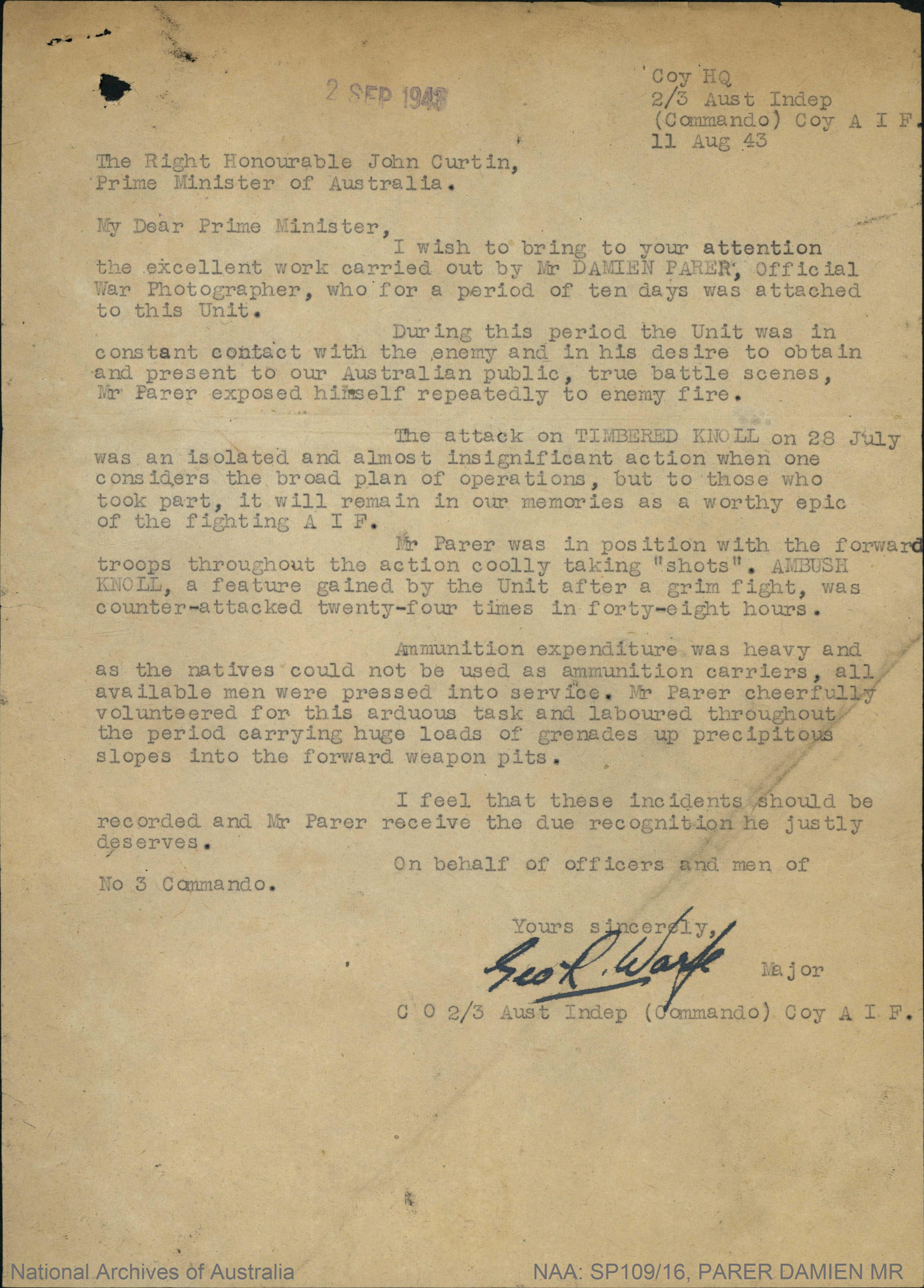
Once that 3 months notice had elapsed:
DAMIEN PARER JOINS THE AMERICANS
LATEST Australian to go over to the Americans is Damien Parer, whose films showing Australian troops in action in the Middle East, Greece, Crete, New Guinea and the South Pacific, put the Australian Department of Information—and Australia —cinematically on the map. Early this month he was accredited a war photographer with Paramount Films, and granted a licence to accompany Allied troops in the SW Pacific area.
The Department of Information won a great victory when Parer resigned in August; they had refused to grant his reasonable request for an increased expense allowance. No doubt the Department is still warmed by a bureaucratic glow at having “shown him”; but they have lost Australia the outstanding photographer produced by World War II in the Pacific.
Parer does not produce mere news-reels; he has the rare gift of capturing the soul of his theme and presenting it to his audience as a living, personal experience.
But bureaucrats do not like ability—their job is to pare down the pennies so that thousands may be more spectacularly wasted in other directions. If we want genius—let’s import it from abroad.' The imported article must be good; the local prophet is notoriously without honour in Australia. DAMIEN PARER JOINS THE AMERICANS, Pacific islands monthly : PIM Vol. XIV, No. 3 (18 Oct., 1943) Retrieved from http://nla.gov.au/nla.obj-329159704
Marriage and a son
Damien married Elizabeth Marie Cotter on 23 March 1944. There seems little doubt that he had met and been dazzled by a few women during his photographic and film career prior to serving, however, a Diary entry from November 27th, 1943, states:
I slept for only ¾ hour. I had a tin of Heinz tomato soup cold.
Next I was worried and began to think about marriage and I feel that Nadeen being a second cousin is unsuitable as Tony suggests. The whole thing boils down to Madge or Marie. As the night wore on I felt more and more that Marie’s very deep love of me is most moving. When she used to write to me in the Middle East I had no trust in her words, possibly humbled herself. Last night this thought came to me with great strength that the love is perhaps the most beautiful thing that has come in my life as far as women go. Alone was like that but Marie had nursed it and had taken all the knock backs and has patiently reduced all my unkindness and still waits.
I directed them to write her a long letter right away and explain my attitude and make it clear to her how wonderful I thought her love was. I also thought if in the morning or during the night I was still resolved to write this letter that I should do so as value sometimes become confused in the silent watches of the night.
What about Moira are you going to dangle her on a string. Does she love you as Marie does at present. The answer is negative. I know if I can track down the war all shots Marie would be the same.
Janet Bell of the ASO on curating a 1964 film of his work, ‘’ The Legend of Damien Parer’’ stated;
If the child is father to the man, then Damien Parer was always true to his beginnings. His faith as a practising Catholic came from his deeply religious parents and his devotion to country was in evidence from his early days at school in Bathurst. This passion was never more evident than when his camera work extolled the men on the front-line who were prepared to fight and die for their country, as indeed was he.
Damien Parer was married in 1944 to the girl he’d first met in 1936 through their local church. As was often the case in those days, the couple waited until he had his first permanent job before marrying.
The papers of the time ran:
PARER-COTTER
The wedding was celebrated at St. Mary's, North Sydney on Thursday, of Elizabeth Mage, elder daughter of Mr. and Mrs. R. V. Cotter, Milner Crescent, Woolstonecraft, and Damien, seventh son of Mr. and Mrs. John Parer, Maleny, Queensland, formerly of Wau,. New Guinea.
The groom's parents were unable to attend. His brother, the Rev. Fr. Adrian Parer, arrived from Brisbane to celebrate Nuptial Mass.
The bride, who has been employed with the Attorney-General's Department, Canberra, was attended by her sister, while the best man was Mr. Ron Williams, Department of Information war correspondent, who was with the groom in the Middle East, Greece and Crete.
Damien Parer won camera fame in the Middle East campaigns for his work and later capped it with the masterpiece, "Kokoda Trail," and other fine war films. He is at present with Paramount. PARER—COTTER (1944, March 29). The Canberra Times (ACT : 1926 - 1995), p. 4. Retrieved from http://nla.gov.au/nla.news-article2674569
DAMIEN PARER MARRIED.
SYDNEY, Thursday. — The war photographer, Damien Parer, was married this morning to Elizabeth Cotter of Sydney, after a six days' engagement. He is the seventh son of Mr. and Mrs. J. A. Parer, formerly of Wau and now of Maleny, Queensland. DAMIEN PARER MARRIED (1944, March 24). Daily Mercury (Mackay, Qld. : 1906 - 1954), p. 4. Retrieved from http://nla.gov.au/nla.news-article170858326
Engaged Six Days
Another whirlwind romance is that of war photographer Damien Parer, who, after a six days' engagement, was married this morning at St. Mary's, North Sydney, to Miss Elizabeth Marie Cotter, of Wollstonecraft. Mr. Parer, who was with a photographic unit in the Middle East and New Guinea, is now attached to Paramount Films. He is the seventh son of Mr. and Mrs. John A. Parer, formerly of Wau, and now of Maleny, Queensland. The bride, who was unattended, wore a Dresden blue suit finished with cherry velvet bows, and a blue velvet toque. Best man, Ron Williams, was a scriptwriter in the bridegroom's unit in the Middle East. Nuptial Mass was celebrated by Rev. Father R. Murphy, S.J., assisted by the bridegroom's brother, Father Adrian, of Brisbane. After a short honeymoon Mr. Parer will leave again for the northern battle areas. A WOMAN'S NOTEBOOK (1944, March 23). The Sun (Sydney, NSW : 1910 - 1954), p. 6 (LATE FINAL EXTRA). Retrieved, from http://nla.gov.au/nla.news-article231828625
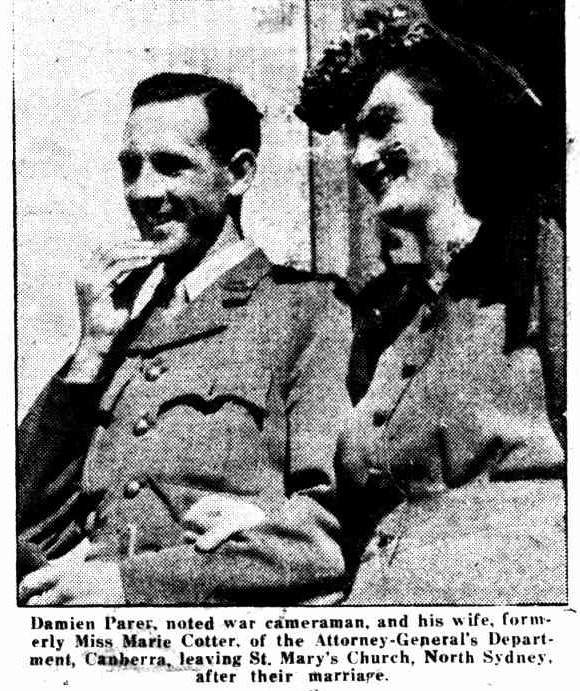
Damien 'Parer, noted war cameraman, and his wife, formerly Miss Marie Cotter, of the Attorney-General's Department, leaving St. Mary's Church, North Sydney, after their marriage. No title (1944, April 3). Wellington Times (NSW : 1899 - 1954), p. 1. Retrieved from http://nla.gov.au/nla.news-article141307852
Wedding Of Famous Cameraman
ACE WAR CAMERAMAN Damien Parer placing the ring oh his M bride's finger at his wedding this morning to Miss Elizabeth Marie Cotter at St. Mary's Church, Ridge Street, North Sydney. At the first attempt he dropped the ring, which rolled down the aisle.
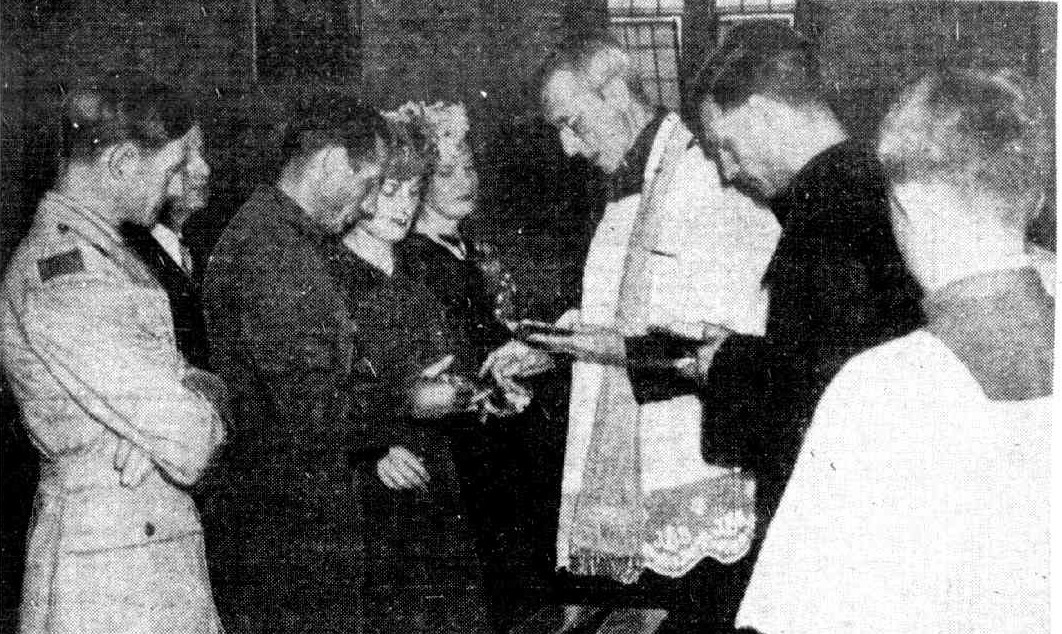
From the left: the best man, Ron Williams, who was in the Middle East with the bridegroom; the bride's father; the bridegroom and bride; the bridesmaid, Miss Doreen Cotter; Father Murphy, who officiated; and Father Adrian the bridegroom's brother. Wedding Of Famous Cameraman (1944, March 23). Daily Mirror (Sydney, NSW : 1941 - 1955), p. 1 (War News Edition). Retrieved from http://nla.gov.au/nla.news-article272231821
Elizabeth Marie Cotter, born in 1914, was the eldest daughter of Robert Vincent and Brigid Agnes (nee Gilligan) Cotter who married in 1913. Her sister Agnes Doreen was born in 1916.
These wedding photos are likely to have been taken by Max Dupain - they are in the State Library of NSW album ;''Album of photographs which include portraits of Parer as a boy; his wedding to Elizabeth Marie Cotter 23rd March 1944 and unofficial war photographs. Numerous portraits of Damien Parer.''
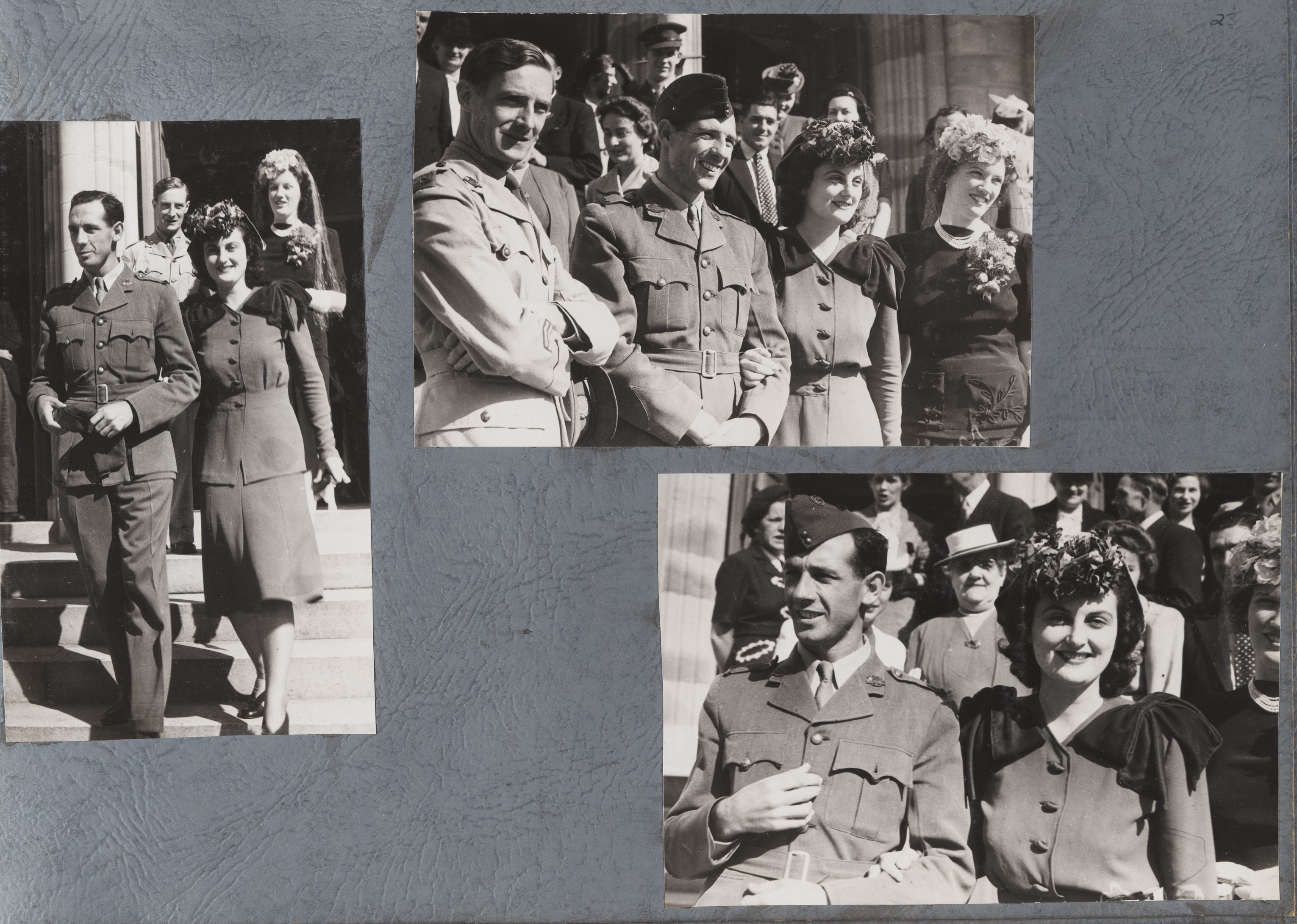

DAMIEN PARER'S VISIT
Damien Parer the famous war photographer, paid a visit to Bathurst yesterday with his wife. They are on their honeymoon, having been married in Sydney only five days ago. Mr. Parer, who is an old St. Stanislaus College boy, visited there yesterday and received a cordial welcome from the priests, some of whom knew him as a fellow student, and from the boys. He was the guest at an informal entertainment at the college last night when he also gave an address to the students, relating many interesting incidents connected with his activities as a war photographer. He has been in the thick of the fighting on many battlefronts and his work as a photographer is highly regarded not only in Australia but in Great Britain and the United States. He is one of the many former pupils of the College who have distinguished them-selves in various walks of life. Mr. Parer was a student there from 1923 until 1928. He is now employed by Paramount as a' war photographer and is accredited to both the Australian and US: fighting forces in the Pacific battle zone. His cousin, Ray Parer, the well known airman, was al-so a pupil of the college.
It was during his student days that Mr, Damien Parer developed his first photograph with the College Camera Club. He volunteered as Official Department of Information photographer with the AIF and sailed in 1940 with the first contingent. During the period he was in the Middle East he photographed the Syrian campaign, two Libyan campaigns and the siege of Tobruk. He also did work for the Navy and Air Force.
He was later recalled and sent to New Guinea where he won the Motion Pictures Academy Award for the newsreel 'Kokoda Trail.' In this war theatre he also filmed the guerrillas in Timor, the assault on Salamaua and recorded the Bismarck Sea battle from a Beaufighter. He returned to Australia where he resigned from the Department of Information and joined the New York Paramount News office. For them he photographed the landings at Cape Gloucester Arawe and the Admiralty Islands. Mr and Mrs. Parer left Bathurst last night. DAMIEN PARER'S VISIT (1944, March 29). National Advocate (Bathurst, NSW : 1889 - 1954), p. 2. Retrieved from http://nla.gov.au/nla.news-article163871867
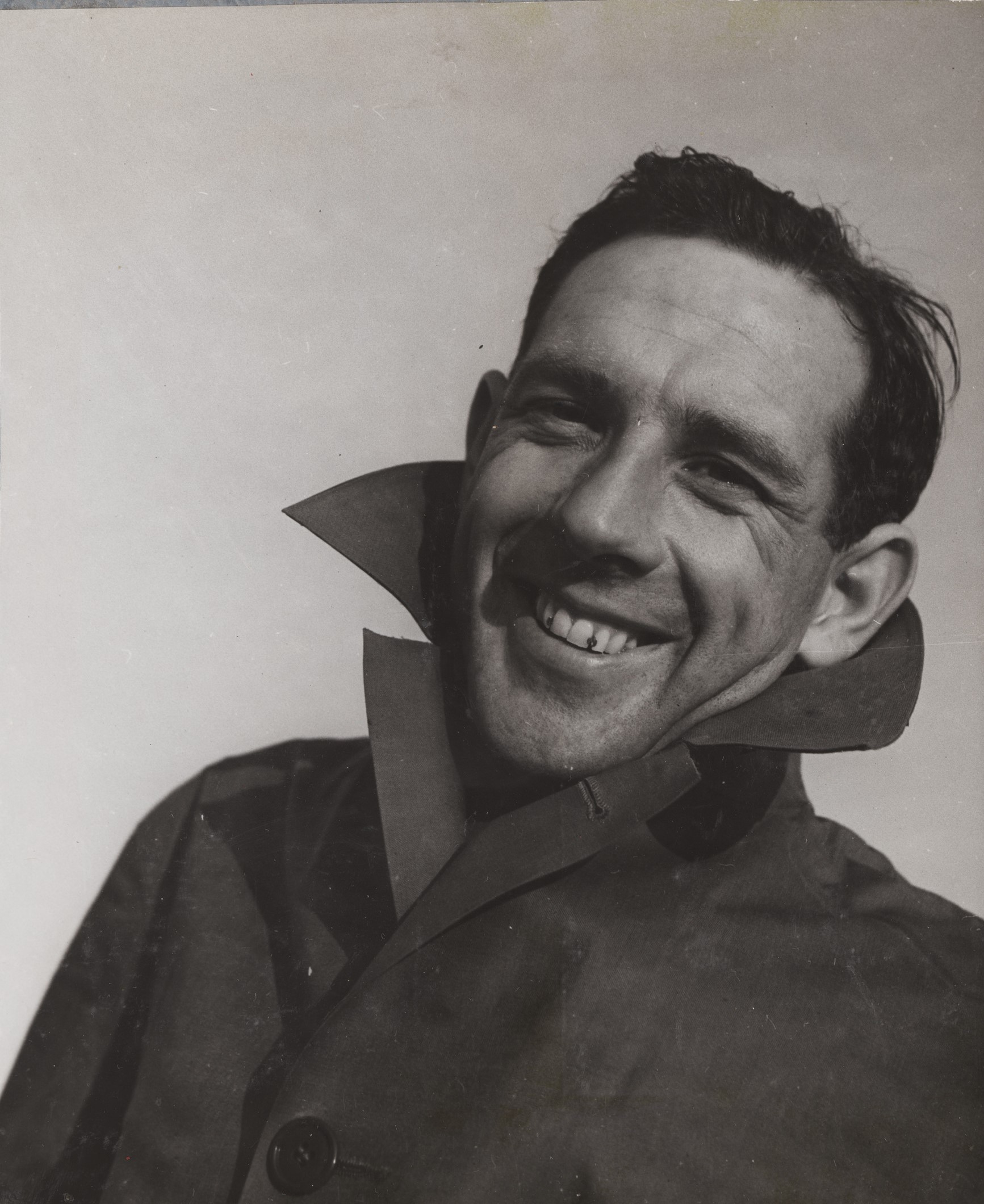
Photographed by Max Dupain on roof of studio in Clarence street, July 1944. Item: c27111_0031_c, courtesy State Lbrary of NSW
Max took these photos of Mrs Parer at Wollstonecraft on September 13 1944, when she was 4 months pregnant:
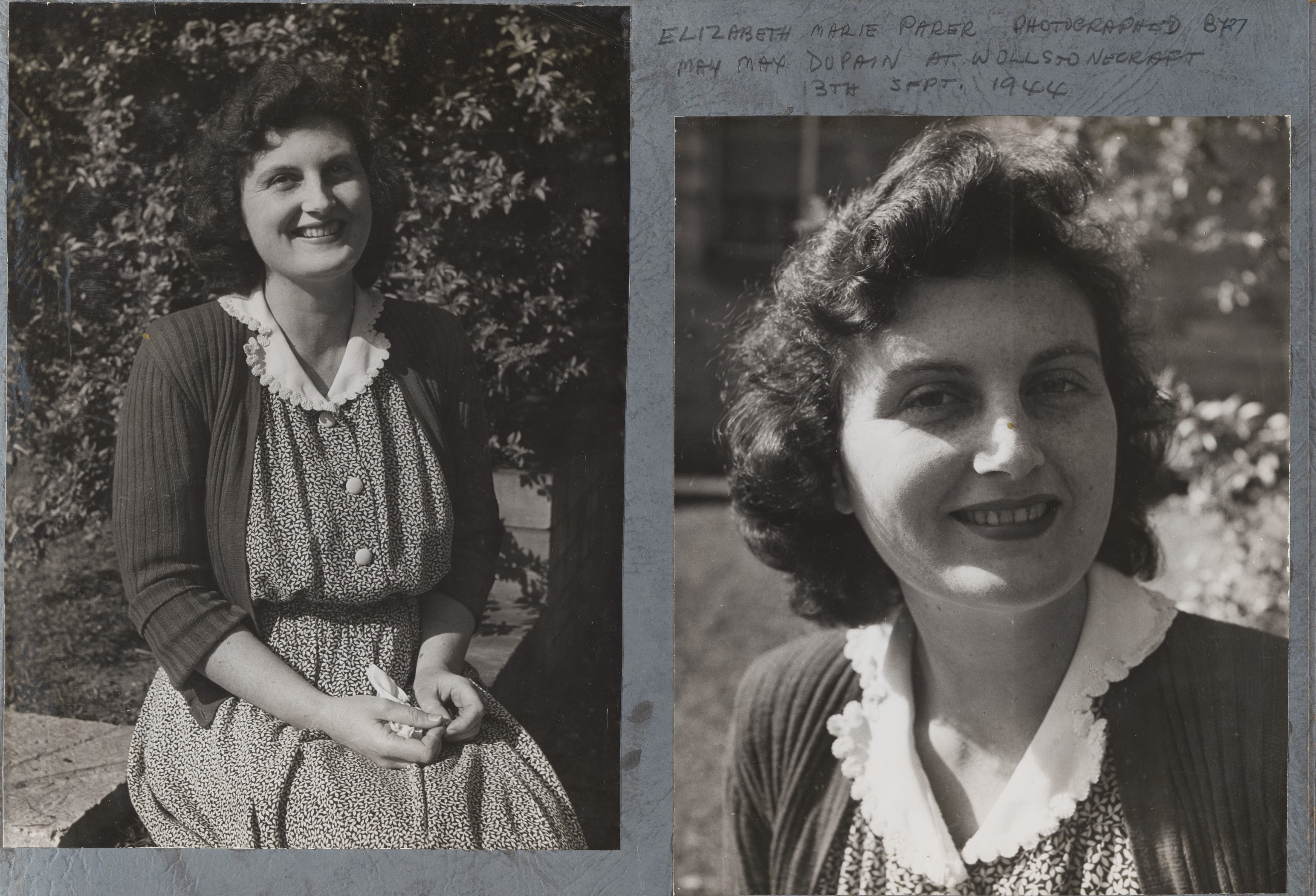

Killed in Action
Damien Parer was killed on 17 September 1944 by Japanese gunfire while filming a United States Marine advance in Palau on the island of Peleliu. He was just 32 years of age. He was reported to have been walking backwards behind a tank to capture the expression in soldiers' eyes as they went into action.
According to records held by the Australian Archives, his wife didn't receive official notification of this until mid 1945 and may have read about it in newspapers first - all of which, across Australia, ran something. A few examples:
DAMIEN PARER KILLED
ACE WAR PHOTOGRAPHER.
Damien Parer, the best-known Australian war photographer in this war, was killed in action by enemy machine-gun fire on Peleliu Island on September 17. The United States Navy Department announced this on Sunday.
Parer, who was employed by the United States film company, Paramount Pictures, was filming front-line operations when he was killed. On March 23 this year Mr. Parer married Miss Elizabeth Marie Cotter, of Wollstonecraft. DAMIEN PARER KILLED (1944, September 26). Dungog Chronicle : Durham and Gloucester Advertiser (NSW : 1894 - 1954), p. 2. Retrieved from http://nla.gov.au/nla.news-article140580762
An eyewitness report states:
Parer Died At His Post
From J. E. Vine
The ace Australian news-cameraman, Damien Parer, died as he got his pictures — in the front line.
John Brennan, Sydney Bulletin war correspondent, brought first-hand news of Parer's death when he joined MacArthur's headquarters yesterday. Brennan was with Parer at Peleliu. He said that he and Parer were following tanks into action across a swampy isthmus. Parer was following behind the first tank and Brennan was behind the second. They fanned out and separated. Damien was killed 75 yards further on by a machine-gun burst, falling 12 yards in, front of a Jap pillbox. Parer Died At His Post (1944, September 29). The Courier-Mail (Brisbane, Qld. : 1933 - 1954), p. 3. Retrieved from http://nla.gov.au/nla.news-article48952690
HOW DAMIEN PARER MET HIS DEATH
From John Loughlin. at Gen. MacArthur's Headquarters. September 28 - An eye witness account of how Damien Parer met his death In the fighting in the Palaus. was given by John Brennan, of the Sydney 'Bulletin.' who has arrived here. Parer was killed during an advance across the strongly defended is land of Peleliu on September 17. two days after the initial landing, says Brennan. They were together ten minutes earlier. As usual Parer was with forward troops. He and Brennan were following tanks In across a swampy Isthmus to oc-cupy the peninsula. 'Damien, with his camera at the ready, went In with the first squad behind the first tank,' said Brennan. 'I was behind the second. We fanned out and separated, and after ad-vancing another 75 yards Damien was hit by machine gun fire. He fell twelve yards in front of a Japanese pillbox.' - Barrier Daily Truth (Broken Hill, NSW : 1908; 1941 - 1954), Friday 29 September 1944, page 1
A tribute that mentions John Brennan again:
Damien Parer.
‘Ek Bum’s” farewell:
He never failed to come to see me within a few hours of landing in Sydney. At first it was in an Australian uniform, later in American. The uniform was always neat and trim and well-fitting. Even in the last few months, when malaria and atabrine had left their marks on his bright face and spare form, he was always gay and sprightly. It is difficult to believe that he is dead, killed by Japanese machine-gun bullets in Peleliu.
There would be a crisp knock at the door and there Parer would be: slender, laughing, dark Spanish eyes dancing with the life and courage behind them. Then he would launch without ado into whatever theme was in his mind. He might have come straight out of a battle —he thus arrived fresh from the Bismarck Sea—or he might have stolen through jungle and moss forest to lie concealed under the noses of the Japanese, leisurely putting their secrets on the film.
He did everything at a great pace, but he did it well, and it has fallen to the lot of few men to leave behind so fine a record of their experiences and of their own personal gallantry.
Many of those dream-light pictures of the route of the Australian retreat in Greece were Parer’s, including the really great film of the bombing of the Australian headquarters at Elassona. Damien and a companion were having lunch on a height above the little town when the Stukas came down. He reached for his camera and made that superb record.
To hundreds of thousands the world over Parer’s films of the Kokoda trail and its aftermath brought the realities of that terrible adventure home. His pictures of the front-line fighting beyond Salamaua have no parallels, and his re-creation of the Battle of the Bismarck Sea, filmed from a Beaufighter screaming along the surface, mast-high, is a classic among battle classics.
Beyond the fact that it was acclaimed by every fighting man who knew him that he was utterly fearless and utterly devoted to his job, and that no risk stood in the way of his doing it thoroughly, he was a man with a good mind, an accurate and cool observer of detail, who could be depended on to give a conservative description of the most exciting events and to strip of their exaggerations accepted versions of happenings in which he had taken part. If he had not been a great photographer he would have been an equally great war correspondent, for he had more military technical knowledge and more battle sense than the majority.
Parer was a good Australian. For a long time he resisted tempting offers to leave the parsimonious and short-sighted Information Department to enter American service. He capitulated to circumstances only when he was about to marry the girl whose life he shared for only a few weeks. They were married in March.
Above all, he was kind-hearted, considerate and generous to a fault. If you knew him you were always involved in a contest with him to prevent him giving you something or doing some little service. In fact, the very last time he was in The Bulletin office he came back, after he had said good-bye, to carry out a kindly after-thought. It had occurred to him that John Brennan, The Bulletin’s man in the Mid-Pacific, to whom he had only once spoken, was married. He offered to carry a letter from Mrs. Brennan to her husband. Then he went off laughing, full of excitement at the prospect of filming the great battles which were then known to be imminent somewhere up above the Line. Damien Parer., The Bulletin Vol. 65 No. 3372 (27 Sep 1944) Retrieved from http://nla.gov.au/nla.obj-540141704
Damien Parer's body was initially buried in a shallow grave on Peleliu but later exhumed and moved to Makassar War Cemetery, Celebes, South Sulawesi, Indonesia in 1946. Here again his wife received a short brusque notification and little else.
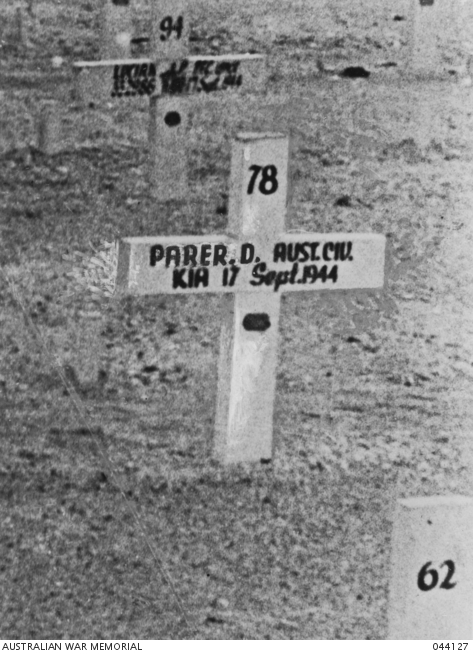
Caption via AWM: THIS SIMPLE CROSS MARKS THE RESTING PLACE OF DAMIEN PARER - A LEGEND IN HIS TIME.
His remains were then moved, again, to a resting place location in Ambon War Cemetery, Pandan Kasturi, Kota Ambon, Maluku, Indonesia when all the graves in Makassar were relocated there in 1961.
His son, also named Damien, was born in 1945, 5 months after his father had died. The younger Damien became a film and TV producer, without the benefit of his father's presence.
PARER (nee Cotter).-On February 15, at Mater Misericodiæ Hospital, Sydney, to Elizabeth and the late Damien Parer-a son. Family Notices (1945, February 16). The Argus (Melbourne, Vic. : 1848 - 1957), p. 2. Retrieved from http://nla.gov.au/nla.news-article1111029
Damien Parer's Son
SYDNEY.- Damien has already been selected as the Christian name for a son born to the widow of Damien Parer, Australia's war cameraman. Both mother and son are doing well.
Parer was killed on September 17 while filming the Peleliu invasion for Paramount to which he transferred from the Department of Information. Damien Parer's Son (1945, February 17). Border Watch (Mount Gambier, SA : 1861 - 1954), p. 3. Retrieved from http://nla.gov.au/nla.news-article78093838
His estate was left to his widow:
DAMIEN PARER'S £1403
The gross value of the estate left by the late Damien Peter Parer, formerly of Maleny, war correspondent and photographer, who was killed last year during operations in the S.W. Pacific, has been sworn for probate purposes at £1403, consisting entirely of personalty. The estate was left to his widow. DAMIEN PARER'S £1403 (1946, May 16). The Courier-Mail (Brisbane, Qld. : 1933 - 1954), p. 6. Retrieved from http://nla.gov.au/nla.news-article50290376
These items, the 'Personal belongings of war correspondent Damien Parer killed on Pelelin Is. Palau Group 1944; a) Helbros watch with Khaki strap, b) Kangaroo leather, brown wallet in which rosary beads were found, c) Rosary beads' - are held in the collections of the State Library of New South Wales;
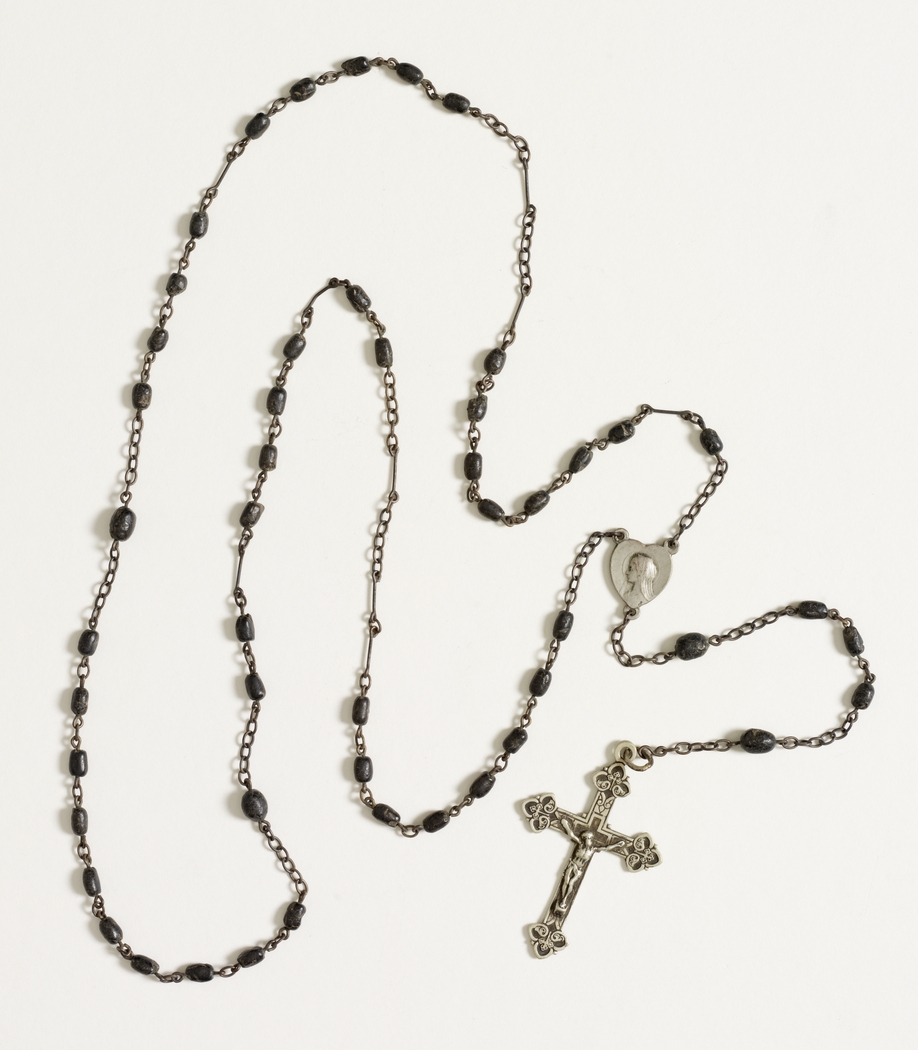
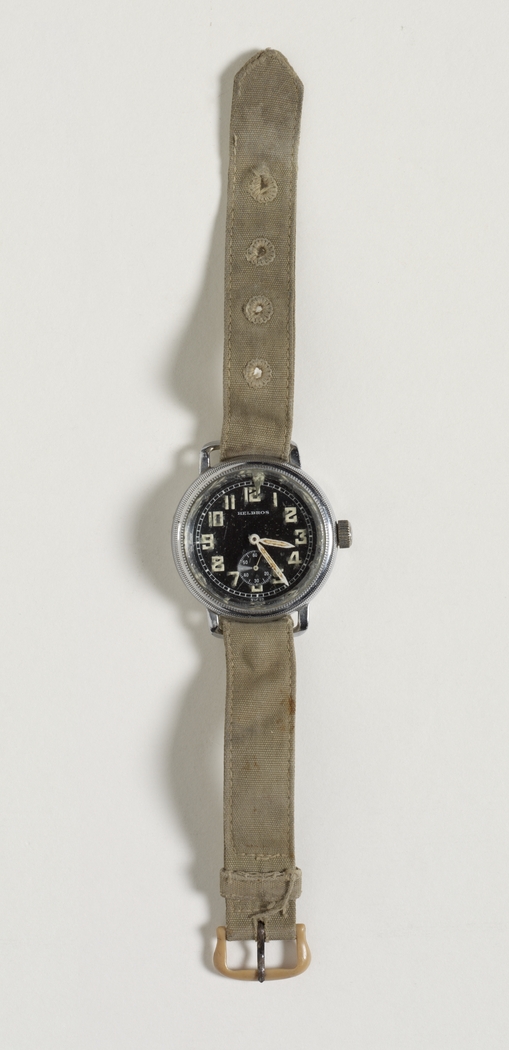
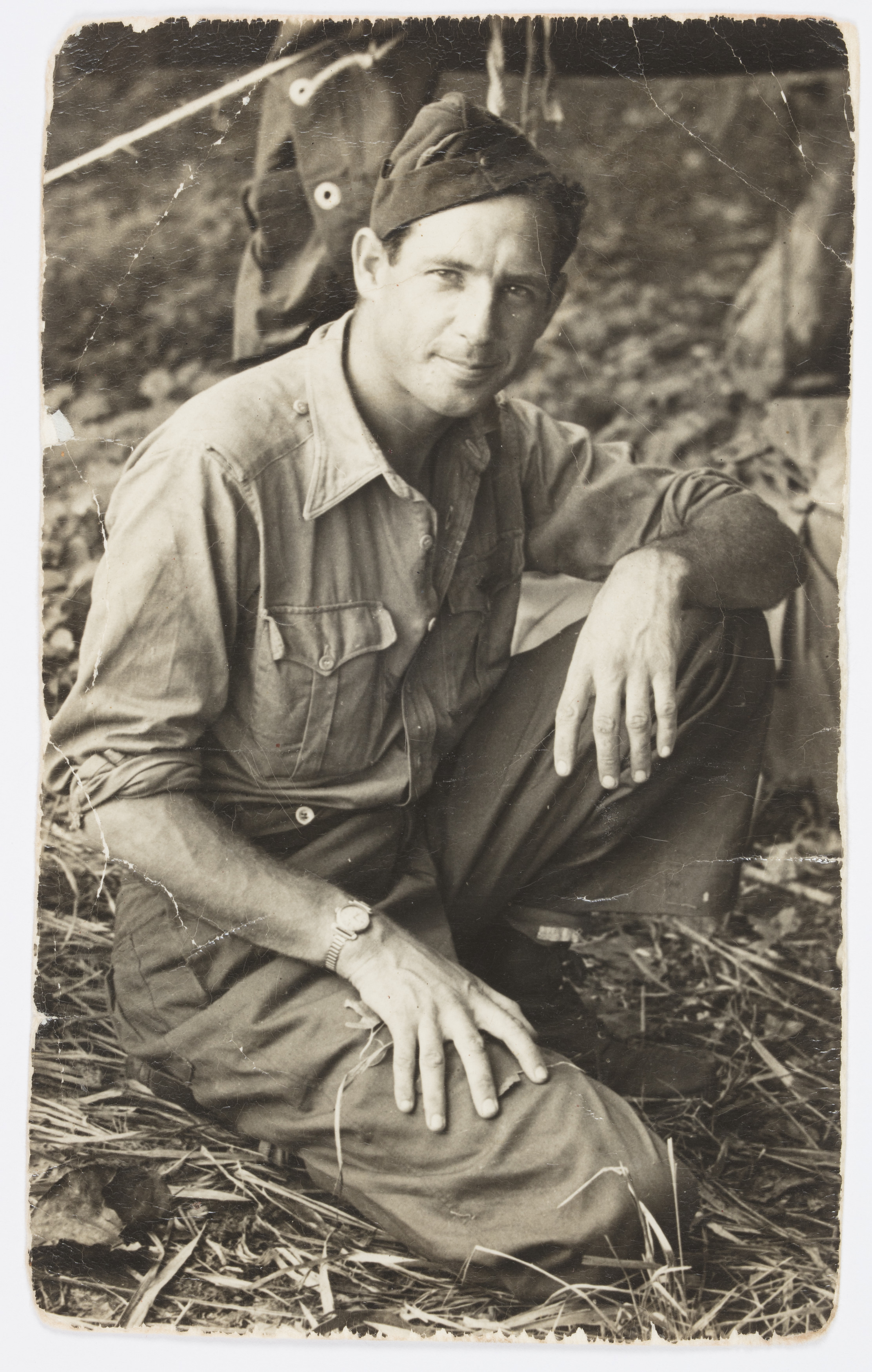
Damien Parer, circa 1943, from: 'Leather money wallet containing 1. Photograph of Damien Parer, inscribed on verso 'War correspondent, I.H.Q. Press, A.P.O. 500, Damien, New Guinea, 1943. Stamped 'Photo by U.S. Army Signal Corps'. 2. Prayer card for Damien Parer.' courtesy Mitchell Library, State Library of New South Wales
His wife eventually married again:
ENGAGEMENT is announced of Mrs. Elizabeth Marie Parer, of Brisbane, widow of the late Damien Parer, and daughter of Mr. and Mrs. R. V. Cotter, of Mona Vale, N.S.W., to Ronald Bowman, of Brisbane. The marriage will take place in August. Social Topics from Town and Country (1950, June 1). Catholic Weekly (Sydney, NSW : 1942 - 1954), p. 2 (PAGES FOR WOMEN). Retrieved from http://nla.gov.au/nla.news-article146740961
Family anecdotes recall Damien Parer was a devout Catholic who always sought to serve God through his work as a photographer and cameraman, always aiming to 'catch the light' and human condition and communicate that through his images.
Ken Hall of Cinesound summed up his opinion:
Damien was quite a man and a genuine character in his own right, warm, human, fallible. He was a good cameraman but there were lots of good cameramen on both sides in World War Two. Damien’s great gift was knowing what to shoot, to look for the human interest angle, to remember the dictum – people are interested in people. His other great natural gift was an uncanny knack of being in the right place at the right time. A cameraman cannot write the story after the event, as war correspondents could and invariably did. The cameraman has to be there when it happens! [3.]
Neil McDonald, in is biography, stated:
''Parer was more than a combat cameraman and propagandist. His films were narratives about the human situation. They reflected his wide reading in the theory of cinema, especially the ideas of John Grierson. Parer's record of the everyday lives of servicemen anticipated the cinéma-vérité style of documentary. His images of a caped soldier crossing a stream, and of a Salvation Army officer lighting a cigarette for a wounded digger (framed like a Renaissance altar painting), became part of the Anzac legend. Parer was a self-effacing man and a devout Catholic. Osmar White described him as 'long, stooped, black-headed, sallow-faced, smiling', and remembered his infectious, 'bubbling bass hoot' of a laugh.''
The gentleman himself stated:
MONDAY 22ND NOVEMBER, 1943
Awakened this morning for Wewak mission, but it was cancelled. There is some fine writing in this diary that carries on, but I’ll have to skip it now.
We photographers don’t actually realise the powerful weapon we hold in our hands, a weapon not only of immediate value but in the future it will be another stone in the building of an Australian tradition. Our sons will see with their own eyes the story of the cream of our own youth of their country who are now surely dying.
I find my faith means more and more to me. This devotion to Our Lady is wonderful. I am sure I could never carry on my work or feel as much in sympathy with our boys if it weren’t for this Grace. I feel quite ready to die, the thoughts of being killed on a mission is not one of great alarm, as if my mother is interceding for me, everything must be for the best.
His Service for Australia included being at the front of the most dangerous front lines of battle during this conflict. That list of filmed work incudes:
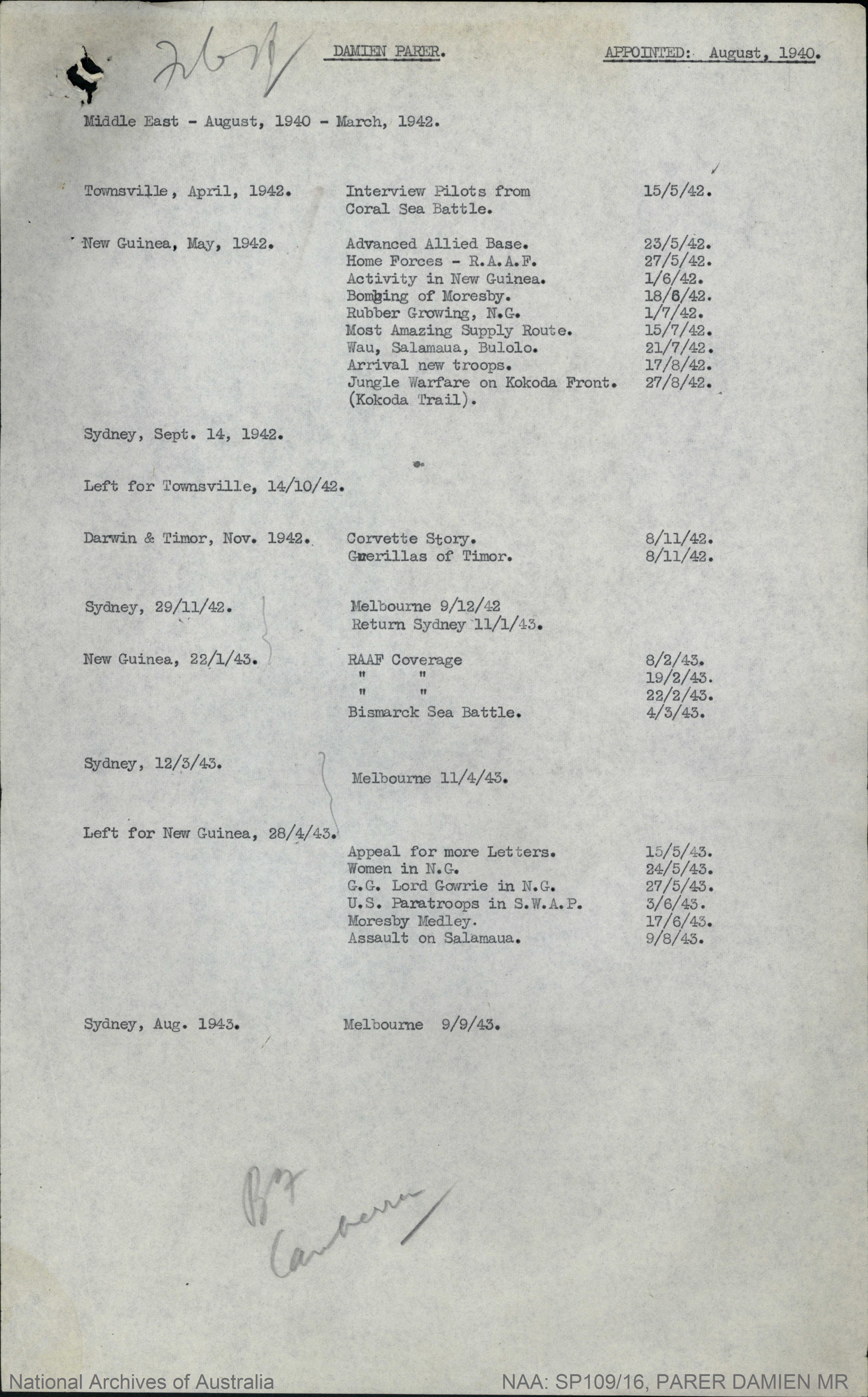
As Australia's first official Australian photographer and cinematographer in WWII Damien Parer certainly established a few Australian traditions simply through his commitment to keeping his images true and about truth and capturing 'what is there' so that alone can be communicated.
Although he only had a few moments in Pittwater prior to enlistment, hopefully Damien took a few bright memories of Bungan and Newport beach to flit through his eyes during those dark loud nights before his next dawn foray to record what was happening to people throughout the places he went during this conflict. He was, clearly, a man of laughter and light.
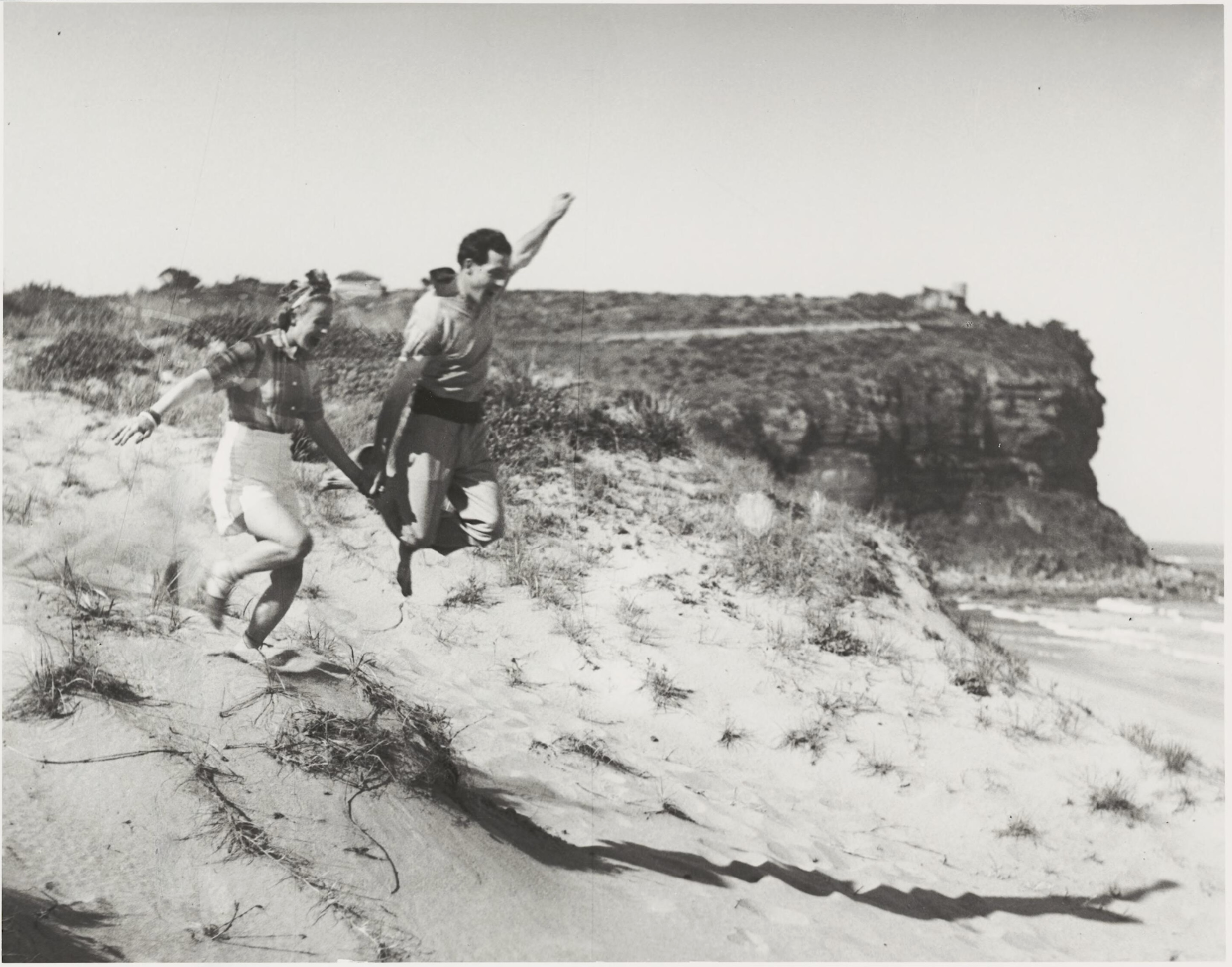
Damien Parer and Jenny Brereton at Bungan, 1938 – photo taken by Olive Cotton - courtesy Mitchell Library State Library of NSW, also available in National Library of Australia
References - extras
- TROVE - National Library of Australia
- State Library of NSW
- PARER HISTORY- Parer's from Catalonia to Australia website at: https://parerhistory.wordpress.com/
- Album of photographs which include portraits of Parer as a boy; his wedding to Elizabeth Marie Cotter 23rd March 1944 and unofficial war photographs. Numerous portraits of Damien Parer, courtesy State Library of NSW
- ‘Frank Hurley : a photographer's life’, Alastair McGregor, 2019, NLA Publishing, p. 389
- Neil McDonald, 'Parer, Damien Peter (1912–1944)', Australian Dictionary of Biography, National Centre of Biography, Australian National University, https://adb.anu.edu.au/biography/parer-damien-peter-11339/text20251, published first in hardcopy 2000
- A Historic Catalogue And Record Of Pittwater Art I – Of Places, Peoples And The Development Of Australian Art And Artists: Artists and Artists Colonies (Max Dupain and parents at Newport section) - Issue 321 Pittwater Online News, July 2017
Lot 35, 15 Calvert Parade Newport - Duapqin home/weekender - from HRLV records: Lot 35, 15 Calvert Parade Newport, first part of the acreage sold by Thomas Copley Calvert to the Intercolonial Investment Land and Building Company in 1910, and consequently sold to Barbara Wallace Brooks as part of the Calvert Ocean Beach Estate subdivision, was then onsold to Harriet Margaret Wilson in January 1920 and then, on May 3rd, 1920, purchased by Thomasine Jane (Ena) Dupain, became the weekender and retirement home of the Dupain family. It was only sold out of the family after Max passed away.

Lot 35 Dupain Newport.jpg?timestamp=1713196007963)
 Lot 35 Dupain Newport.jpg?timestamp=1713196058034)
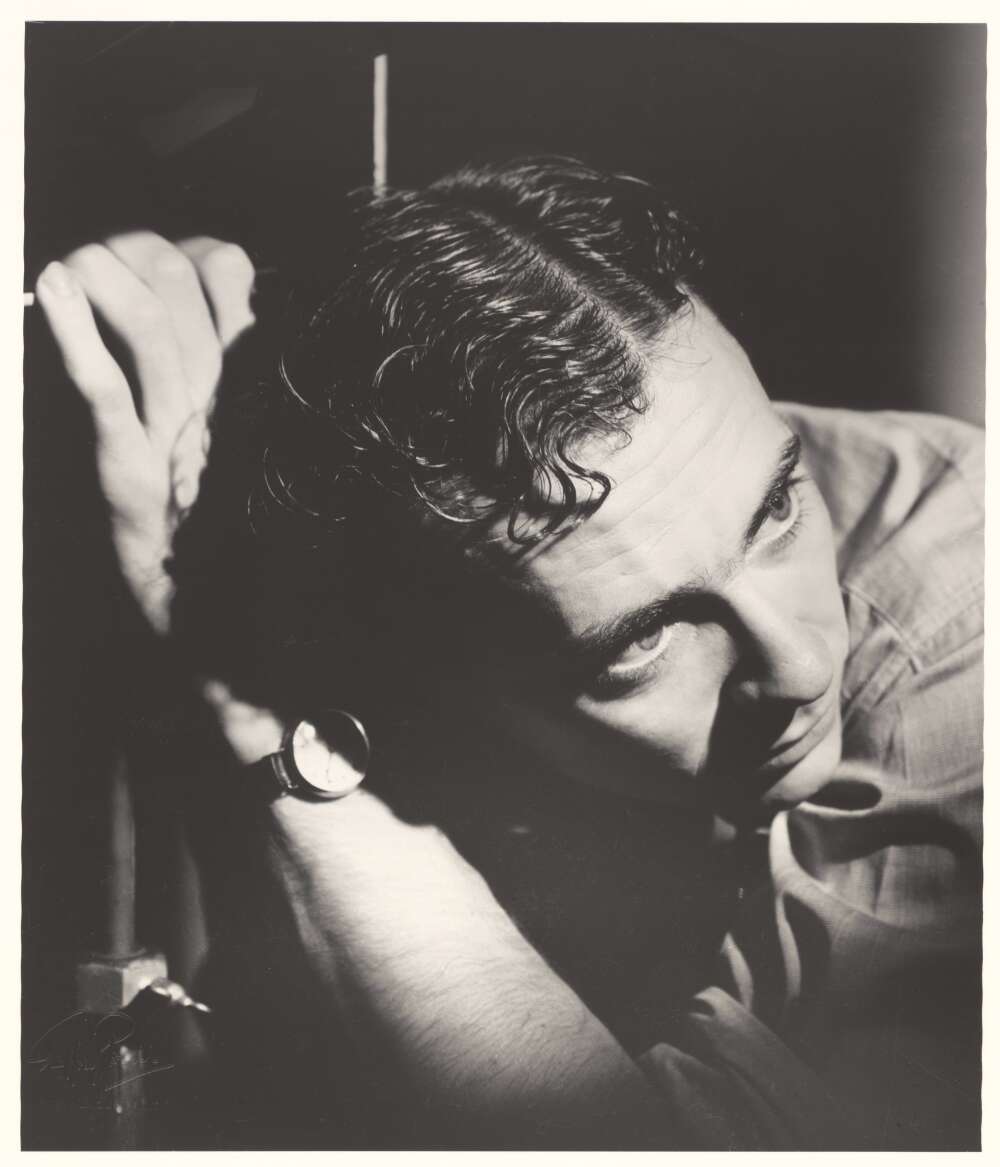
Photo By Powell, Geoffrey. (1938). Portrait of Max Dupain, the well known Sydney photographer, 1938 Retrieved from http://nla.gov.au/nla.obj-150066220
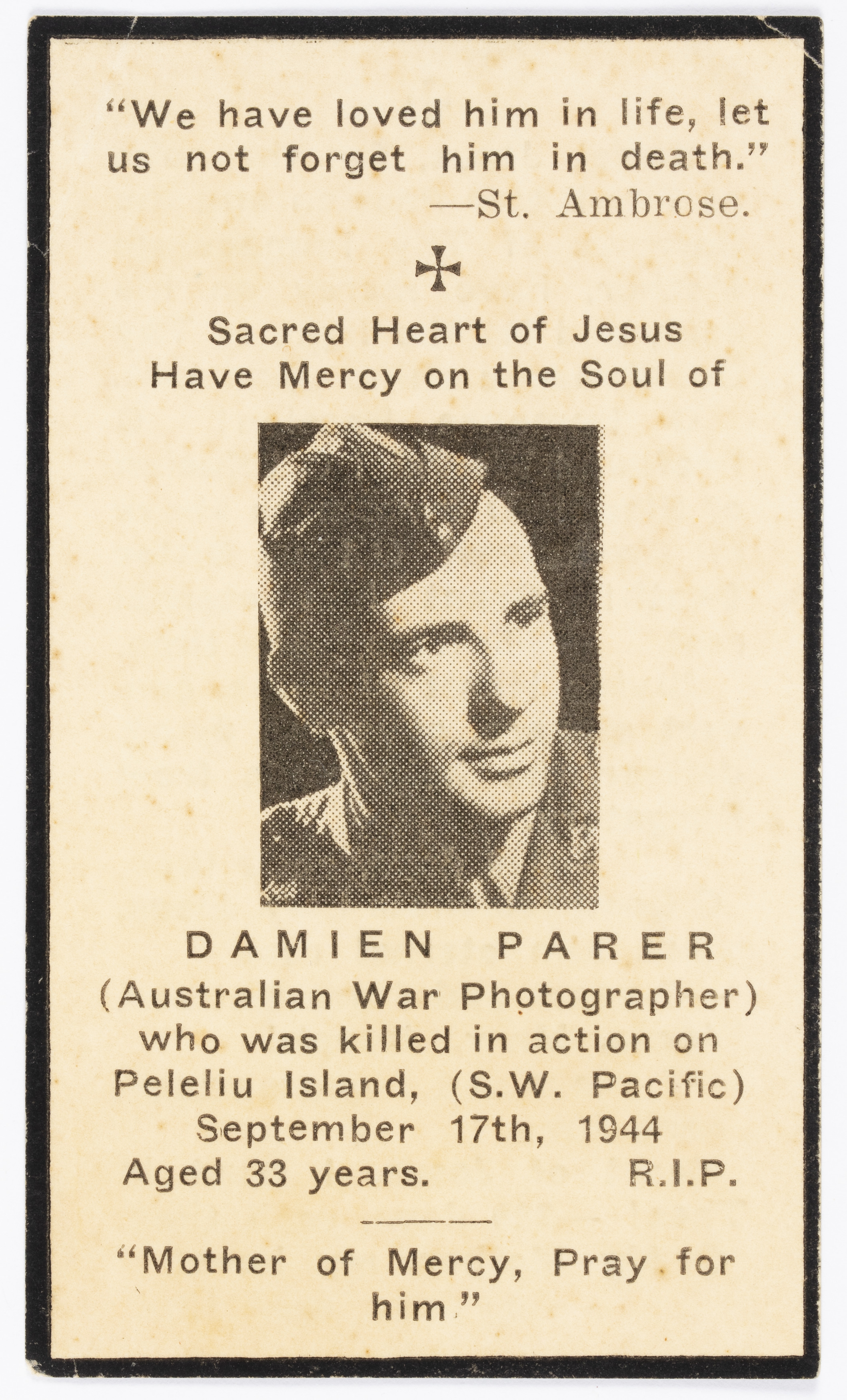
Damien Parer, circa 1943, from: 'Leather money wallet containing 1. Photograph of Damien Parer, inscribed on verso 'War correspondent, I.H.Q. Press, A.P.O. 500, Damien, New Guinea, 1943. Stamped 'Photo by U.S. Army Signal Corps'. 2. Prayer card for Damien Parer.' courtesy Mitchell Library, State Library of New South Wales
Damien's wife – birth
COTTER ELIZABETH M 13331/1914 ROBERT V BRIDGET A SYDNEY
Marie sister's birth: COTTER AGNES DOREEN 40322/1916 ROBERT V BRIDGET A REDFERN
Wife's Mother died:
COTTER, Brigid Agnes — September 15, 1950, at her residence, 44 Grand View Parade, Mona Vale, beloved wife of Robert Vincent, fond mother of Marie (Mrs Parer, Brisbane, Qld ) and Doreen and grandmother of Damien Robert Parer. Requiescat in pace. Family Notices (1950, September 16). The Sydney Morning Herald (NSW : 1842 - 1954), p. 46. Retrieved from http://nla.gov.au/nla.news-article18173053
20833/1950COTTER BRIGID AGNES parents: PATRICK BRIDGET death registered at MANLY
Father's death: COTTER ROBERT VINCENT 44031/1968 parents: THOMAS CHARLOTTE death registered at GOSFORD
Death of J. A. Parer
The death has occurred at the Brisbane hospital of Mr. John Arthur Parer, 85.
He was the father of Australian war photographer, Damien Parer, who was killed in the Islands during a front line filming assignment. Another son is Father Ferdinand Parer, a Franciscan missionary in New Guinea. The late Mr. Parer had been in the hotel business until his retirement some years ago. The funeral will take place tomorrow from the Church of the Little Flower, Turner Road, Kedron, at the conclusion of Requiem Mass at 9 a.m. It will move to Lutwyche Cemetery. Death of J. A. Parer (1953, March 12). Brisbane Telegraph (Qld. : 1948 - 1954), p. 2 (LAST RACE). Retrieved from http://nla.gov.au/nla.news-article217250554
PARER. John A.— The Relatives & Friends of Rev. Father Ferdinand, O.F.M., Mr. & Mrs. S. A Parcr. Mr. & Mrs; . C. G. Parer, Mr. & Mrs H. J. Owen. Mr. ben Parcr. Mrs. A. F. Farer. & Mrs. Damien Parer, are invited to attend -the Funeral of their beloved Father At Father-in-law. John Arthur Parer, of Golda Avenue,' Salisbury. to leave the Church of the Little Flower. Turner Road, Kedron, on conclusion of Solemn Requiem Mass, commencing To-morrow. Friday, at 9 a m„ for Lutwyche Cemetery. Family Notices (1953, March 12). Brisbane Telegraph (Qld. : 1948 - 1954), p. 6 (LAST RACE). Retrieved from http://nla.gov.au/nla.news-article217250602
.jpg?timestamp=1713137899726)
The Parer Family (1920, August 16). The Herald (Melbourne, Vic. : 1861 - 1954), p. 1. Retrieved from http://nla.gov.au/nla.news-article242317552
Death Notices.
PARER, Alfonso.— At Sydney, September 8th 1947, beloved Son of Mr. & Mrs. John A. Parer, Maleny, Brother of Mr. Stan Parer of Melbourne, & of Father F. Parer, Cyril & Ben Parer of New Guinea, also Mrs. J. H. Owen, of Salisbury & the late Damien Parer, war photographer. Family Notices (1947, September 10). The Telegraph (Brisbane, Qld. : 1872 - 1947), p. 4 (CITY FINAL LAST MINUTE NEWS). Retrieved from http://nla.gov.au/nla.news-article201317662
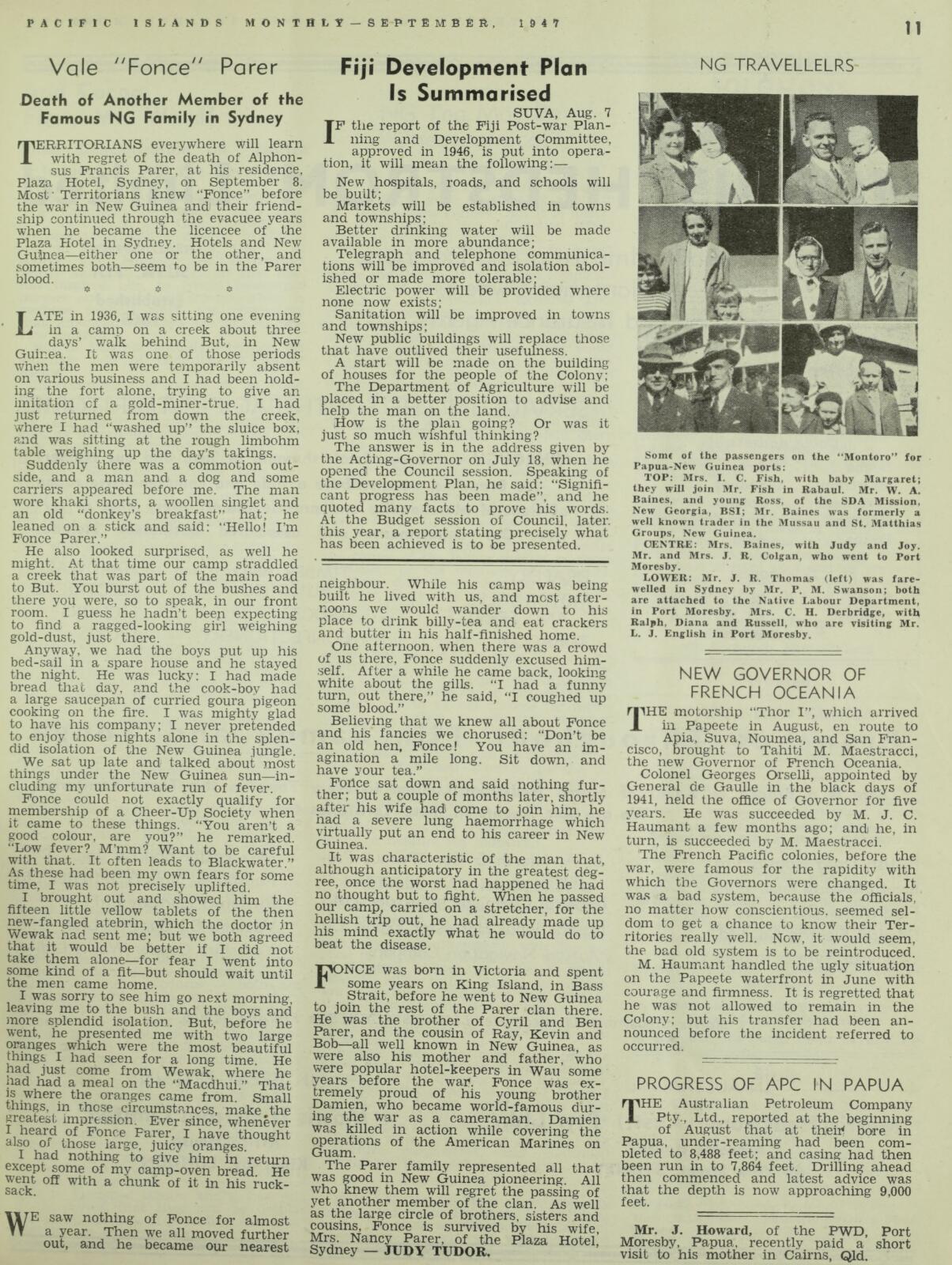
Judy Tudor, Pacific Islands Monthly PIM.Vol. XVIII, No. 2 ( Sep. 17, 1947), page 11.
John Paul Carolin (1835 - 1918)
Bendigo Advertiser; Saturday 13 May 1911 p 9 Article
GOLDEN WEDDING.
CAROLIN -- CORCORAN.
Cr. J. P. and Mrs. Carolin, of Bendigo, celebrated their golden wedding yesterday, they having been married in the Kyneton Roman Catholic Church by the late Dean Geoghan on 12th May, 1861.
Mrs. Carolin's maiden name was Miss Corcoran, and she was a daughter of the late Mr. John Corcoran, of Holy Cross, Tipperary, Ireland. Her father died when she was very young, so that she has practically no recollection of him. In the early days, when the gold fever was at its height, Miss Corcoran was brought to Victoria, and it was while residing at Kyneton that she met Mr. Carolin.
Cr. Carolin was born on 12th June, 1835, in Tasmania, and was the son of the late Mr. Hugh Carolin, of Talbot-street, Dublin, Ireland, who was a member of an ancient Irish firm of builders. For the past 40 years, with the exception of the short period of 13 months, Cr. Carolin has represented ratepayers in municipal government. For 12 years he was a member of the Kyneton Shire Council and then, when he transferred his residence to Bendigo he became a member of the City Council. During his long municipal career Cr. Carolin has only been permitted to enjoy two walkovers at elections -- one 25yearsago and the other last August. While he has been a councillor Cr. Carolin has never been defeated in a contest, but on one occasion, when he did not hold office, he was, after a strenuous and costly battle, ordered by the ratepayers to stand aside.
Cr. Carolin has played an important part in the business history of this city, while at the same time he has also used his energies in the best interests of the rate payers. Both Cr. and Mrs. Carolin, who still enjoy the best of health, were the recipients of many congratulatory messages yesterday.
Occupations.
1868: CAROLIN J P Auctioneer Kyneton Victoria (Baillies Directory )
1871-1872: CAROLIN J P Auctioneer Kyneton Victoria
1875: Photographer Kyneton Victoria
1886-1913: Councillor at the City of Bendigo. Elected in 1886 and remained on Council until 1913, serving two terms as Mayor 1889-1890 to 1907-1908
1903: At time of marriage, a merchant, residing Queen Street Bendigo, Merchant
Death. John died 4th February 1918, at Malvern, Victoria, aged 82.
The Argus (Melbourne) Wednesday 6 February 1918: DEATHS
CAROLIN. —On the 4th February, at his residence, 9 Irving street, Malvern, John Paul Carolin (late of Bendigo), in his 83rd year. R.I.P. Requiem Mass, St. Joseph's, Stanhope street, Malvern, Wednesday, 6th inst., at 10 a.m.
The Argus (Melbourne) Wednesday 6 February 1918:
Obituary
Mr John Paul Carolin who died at his residence Malvern on Monday was a former councillor and mayor of Bendigo. Mr Carolin who was in his 83rd year, was born in Tasmania. He came to Victoria as a young man, and entered into business at Kyneton. He commenced his municipal career by being elected to the Kyneton Shire Council. In 1870 Mr Carolin went to Bendigo and established a machinery business which he carried on until a few years ago. In 1880 he was elected to represent Darling Ward in the Bendigo City Council and he held the seat continuously until failing health caused his retirement in March 1913. He was twice mayor of the city. Mr Carolin was a pioneer in the movement for making use of the worked out diggings round Bendigo. It was through him that the Spanish gardeners who established the tomato-growing industry at the White Hills went to Bendigo. After retiring from municipal life he proceeded to Melbourne and directed the business at West Melbourne, of which he was the principal until September last. He leaves a widow, two sons and five daughters. Two of the daughters are married to Mr M Parer and Mr J L Parer, the well-known Melbourne caterers. Mr Carolin had 35 grand-children and two great grand children.
Burial. St Kilda cemetery, St Kilda, Victoria (Roman Catholic-Monumental Grave, Compt A Grave 420). Also in the family grave are: Vincent William Carolin (1915); Mary Carolin (1919); Ronald Bruce Smith (1921).
Sparrow Force
Sparrow Force was a detachment based on the 2/40th Australian Infantry Battalion and other Dutch, British, US and Australian 8th Division units during World War II. The force was formed to defend the island of Timor from invasion by the Empire of Japan. It formed the main part of the Allied units in the Battle of Timor.
The force began deploying in late 1941, and following Japan's entry into the war, it was drawn into the fighting in response to the Japanese invasion of Portuguese and Dutch Timor in February 1942. After heavy fighting around Irekum, the main element of the force – the 2/40th – were forced to surrender on 23 February 1942; however, elements of the force, specifically commandos from the 2/2nd Independent Company, supported by the local population, continued a guerilla campaign and inflicted heavy casualties on the Japanese until August, when the Japanese launched a counter-offensive. Despite reinforcements from the 2/4th Independent Company arriving in September 1942, the Japanese offensive eventually resulted in the withdrawal of Allied troops over the period December 1942 to January 1943, with the commandos being withdrawn by sea. Sparrow Force personnel who were captured during the fighting were sent to Japanese labour camps across south-east Asia, and between 1942 and 1945, many died in captivity.
The majority of Sparrow Force personnel were from the 2/40th Infantry Battalion, which had been formed in Tasmania and was part of the 23rd Australian Infantry Brigade. The force was initially commanded by Lieutenant Colonel William Leggatt, although later command was taken over by Brigadier William Veale before being passed on to Lieutenant Colonel Alexander Spence. A commando unit—the 2/2nd Independent Company (recruited mostly in Western Australia)—was also part of Sparrow Force. With the other forces from the 23rd Brigade, it shared contingents from 18 Anti-Tank Battery, the 2/12th Field Ambulance, 23rd Brigade Signals and the 2/11th Field Company. Zealandia departed Darwin on the morning of 10 December 1941 with 957 troops escorted by HMAS Westralia with another 445 troops reaching Koepang on 12 December.
Rabaul fell to the Japanese on 23 January, followed by Ambon on 3 February, and both Gull Force and Lark Force were destroyed. Sparrow Force was reinforced on 16 February 1942 with 189 British anti-aircraft gunners, from A & C Troops of the 79th Light Anti-Aircraft Battery of the Royal Artillery, most of whom were veterans of the Battle of Britain. They were attacked by Japanese bombers as their ship anchored at Tenau. Later that day, an Allied convoy carrying reinforcements and supplies to Kupang—escorted by the heavy cruiser USS Houston, the destroyer USS Peary, and the sloops HMAS Swan and Warrego—came under intense Japanese air attack and was forced to return to Darwin without landing. The reinforcements had included an Australian pioneer battalion—the 2/4th Pioneer Battalion—and the US 49th Artillery Battalion. Sparrow Force could not be reinforced further and as the Japanese moved to complete their envelopment of the Netherlands East Indies, Timor was seemingly the next logical target.
The 2/40th and most Sparrow Force units were based at Penfui Airfield, outside the capital of Netherlands Timor, Kupang. The 2/2nd Independent Company was based across the border, at Dili in Portuguese Timor.
%20(1).jpg?timestamp=1713166332140)
Signaller Keith Richards, Corporal John Donovan and Sergeant John Henry Sargent (left to right), from the Australian 2/2nd Independent Company, using a radio on a mountain top in Japanese-occupied Timor, in about November 1942. (Photograph by Damien Parer.)
Japanese invasion of Portuguese Timor, 19–20 February 1942
On the night of 19/20 February 1942, a force of 1,518 troops from the Imperial Japanese Army's 228th Regimental Group, which formed part of the 38th Division, XVI Army, under the command of Colonel Sadashichi Doi, began landing in Dili. Initially, the Japanese ships were mistaken for vessels carrying Portuguese reinforcements, and the Allies were caught by surprise. Nevertheless, they were well-prepared, and the garrison began an orderly withdrawal, covered by the 18-strong Australian commando No. 2 Section stationed at the airfield. According to Australian accounts of the resistance to the Japanese landings at Dili, the commandos killed an estimated 200 Japanese in the first hours of the battle, although the Japanese army recorded its casualties as including only seven men. Native accounts of the landings support the Australian claims, however.
Another group of Australian commandos, No. 7 Section, was less fortunate, driving into a Japanese roadblock by chance. According to Brad Manera of the Australian War Memorial, despite surrendering, all but one of their number were executed by the Japanese. Colin Doig provides different figures, though, stating that of the 14 men on the truck, 13 were shot, with one surviving (Keith Hayes) and one (Peter Alexander) being marched away to be a POW for the rest of the war. Both men survived the war. Outnumbered, the surviving Australians then withdrew to the south and to the east, into the mountainous interior. Van Straten and 200 Dutch East Indies troops headed southwest toward the border.
Japanese landings in Dutch Timor, 19–20 February 1942
On the same night, Allied forces in Dutch Timor also came under extremely intense air attacks, which had already caused the small RAAF force to be withdrawn to Australia. The bombing was followed up by the landing of the main body of the 228th Regimental Group—two battalions totalling around 4,000 men—on the undefended southwest side of the island, at the Paha River. Five Type 94 tankettes were landed to support the Japanese infantry, and the force advanced north, cutting off the Dutch positions in the west and attacking the 2/40th Battalion positions at Penfui. A Japanese company thrust north-east to Usua, aiming to cut off the Allied retreat. In response Sparrow Force HQ was immediately moved further east, towards Champlong.
Leggatt ordered the destruction of the airfield, but the Allied line of retreat towards Champlong had been cut off by the dropping of about 500 Japanese marine paratroopers, from the 3rd Yokosuka Special Naval Landing Force, near Usua, 22 km (14 mi) east of Kupang.
After heavy resistance around the village of Babau and a second airdrop of 300 paratroopers, Sparrow Force cleared the village by the night of the 21st with plans to move eastward in the morning. By then, the Japanese had dug in defensive positions on Usua Ridge with a mountain howitzer and heavy machine guns near the road. After an Australian mortar and machine gun barrage, Captain Johnson of A Company, Captain Roff of B Company and Captain Burr of C Company led their platoons in a bayonet charge up the ridge, followed by R Company (Reinforcements). Gunners of the 2/1st Heavy Battery and sappers of the 2/1st Fortress Engineers reinforced the infantry platoons in the action. After the devastating assault on the paratroopers, Sparrow Force had killed all but 78 of the 850 paratroopers. Sparrow Force suffered only a few dozen losses.
Sparrow Force was then attacked from the west by the main Japanese force of about 3,000 men with tanks and artillery units. By destroying the bridges as they advanced east, Sparrow Force achieved only a brief respite. By the morning of 23 February Sparrow Force had been engaged from the rear by the main Japanese force once again. With his men low on ammunition, out of food and water, weary from little sleep, and hopelessly outnumbered, Leggatt surrendered at Irekum on 23 February. Both forces were bombed by Japanese aircraft in two waves at 10:00 am and 10:10 am and more men from both sides were killed. More Japanese then landed at Koepang, which brought their numbers up to about 22,000 in Dutch West Timor.
The 2/40th Battalion had suffered 84 killed and 132 wounded in the fighting, while more than twice that number would die as prisoners of war during the next two and a half years. Veale and the Sparrow Force HQ force who were at Tjamplong and not in the main column at Irekum—including about 290 Australian and Dutch troops—continued eastward across the border, to link up with the 2/2 Independent Company. After months of training, some formed Platoon D of the 2nd Independent Company.]
On their own, February – April 1942
_TO_THE_AUSTRALIANS_OF_SPARROW_FORCE_IN_1942.jpg?timestamp=1713166410406)
Akiu, one of the Timorese, who assisted the Sparrow Force
Between the capitulation at Irekum and 19 April 1942, the communication link with the Australian mainland was broken. By the end of February, the Japanese controlled most of Dutch Timor and the area around Dili in the northeast. However, they could not move into the south and east of the island without fear of attack. The 2/2nd Independent Company was specially trained for commando-style, stay behind operations and it had its own engineers and signalers, although it lacked heavy weapons and vehicles. The commandos were hidden throughout the mountains of Portuguese Timor, and they commenced raids against the Japanese, assisted by Timorese guides, native carriers and mountain ponies. Although Portuguese officials—under Governor Manuel de Abreu Ferreira de Carvalho—remained officially neutral and in charge of civil affairs, both the Portuguese and the indigenous East Timorese were usually sympathetic to the Allies, who were able to use the local telephone system to communicate among themselves and to gather intelligence on Japanese movements. However, the Allies initially did not have functioning radio equipment and were unable to contact Australia to inform them of their continued resistance.
Doi sent the Australian honorary consul, David Ross, also the local Qantas agent, to find the commandos and pass on a demand to surrender. Spence responded: "Surrender? Surrender be *ucked!" Ross gave the commandos information on the disposition of Japanese forces and also provided a note in Portuguese, stating that anyone supplying them would be later reimbursed by the Australian government.
Australian commandos continue to resist, April – August 1942
"Force intact. Still fighting. Badly need boots, quinine, money, and Tommy-gun ammunition."
In early March, Veale and Van Straten's forces linked up with the 2/2nd Company. Included in this group were several specialist electrical engineers. Captain George Parker, Signaller Keith Richards, Corporal John Donovan, Signaller Jack Loveless, and Sergeant Jack Sargeant built a radio out of recycled parts, which they called "Winnie the War Winner", and re-established contact with Darwin. Supplies were soon airdropped to the guerrilla force followed by continuing resupply from the sea.
The Japanese high command sent a highly regarded veteran of the Malayan campaign and the Battle of Singapore, a major known as the "Tiger of Singapore" (or "Singapore Tiger"; his real name is unknown), to Timor. On 22 May, the "Tiger"—mounted on a white horse—led a Japanese force towards Remexio. An Australian patrol, with Portuguese and Timorese assistance, staged an ambush and killed four or five of the Japanese soldiers. During a second ambush, Ray Aitken (an Australian sniper) shot and killed the "Tiger". Another 24 Japanese soldiers were also killed, and the force retreated to Dili. On 24 May, Veale and Van Straten were evacuated from the south east coast by an RAAF Catalina and Spence was appointed commanding officer, after being promoted to lieutenant colonel. On 27 May, Royal Australian Navy (RAN) launches successfully completed the first supply and evacuation missions to Timor.
In June, General Douglas MacArthur—now the Supreme Allied Commander in the South West Pacific Area—was advised by General Thomas Blamey—Allied land force commander—that a full-scale Allied offensive in Timor would require a major amphibious assault, including at least one infantry division (at least 10,000 personnel). Because of this requirement and the overall Allied strategy of recapturing areas to the east, in New Guinea and the Solomon Islands, Blamey recommended that the campaign in Timor should be sustained for as long as possible, but not expanded. This suggestion was ultimately adopted.
Relations between Ferreira de Carvalho and the Japanese deteriorated. His telegraph link with the Portuguese Government in Lisbon was cut. In June 1942, a Japanese official complained that the Governor had rejected Japanese demands to punish Portuguese officials and Timorese and civilians who had assisted the "invading army" (the Australians). On 24 June, the Japanese formally complained to Lisbon, but did not take any action against Ferreira de Carvalho. Meanwhile, Doi once again sent Ross with a message, complimenting Sparrow Force on its campaign so far, and again asking that it surrender. The Japanese commander drew a parallel with the efforts of Afrikaner commandos of the Second Boer War and said that he realized it would take a force 10 times that of the Allies to win. Nevertheless, Doi said he was receiving reinforcements, and would eventually assemble the necessary units. This time Ross did not return to Dili, and he was evacuated to Australia on 16 July.
Japanese counter-offensive, August 1942
In August, the Japanese 48th Division—commanded by Lieutenant General Yuichi Tsuchihashi—began arriving from the Philippines and garrisoned Kupang, Dili and Malacca, relieving the Ito detachment. Their goal was to outnumber the commandos by 100 to 1. The Japanese estimated Sparrow Force to be battalion strength in East Timor.] Tsuchihashi then launched a major counter-offensive in an attempt to push the Australians into a corner on the south coast of the island. Strong Japanese columns moved south—two from Dili and one from Manatuto on the northeast coast. Another moved eastward from Dutch Timor to attack Dutch positions in the central south of the island. The offensive ended on 19 August when the main Japanese force was withdrawn to Rabaul, but not before they secured the central town of Maubisse and the southern port of Beco. The Japanese were also recruiting significant numbers of Timorese civilians, who provided intelligence on Allied movements. Meanwhile, also in late-August, a parallel conflict began when the Maubisse rebelled against the Portuguese.
During September the main body of the Japanese 48th Division began arriving to take over the campaign. The Australians also sent reinforcements, in the form of the 450-strong 2/4th Independent Company—known as "Lancer Force"—which arrived on 23 September. The destroyer HMAS Voyager ran aground at the southern port of Betano while landing the 2/4th, and had to be abandoned after it came under air attack. The ship's crew was safely evacuated by HMAS Kalgoorlie and Warrnambool on 25 September 1942 and the ship destroyed by demolition charges. On 27 September, the Japanese mounted a thrust from Dili towards the wreck of Voyager, but without any significant success.
By October, the Japanese had succeeded in recruiting significant numbers of Timorese civilians, who suffered severe casualties when used in frontal assaults against the Allies. The Portuguese were also being pressured to assist the Japanese, and at least 26 Portuguese civilians were killed in the first six months of the occupation, including local officials and a Catholic priest. On 1 November, the Allied high command approved the issuing of weapons to Portuguese officials, a policy which had previously been carried out on an informal basis. At around the same time, the Japanese ordered all Portuguese civilians to move to a "neutral zone" by 15 November. Those who failed to comply were to be considered accomplices of the Allies. This succeeded only in encouraging the Portuguese to cooperate with the Allies, whom they lobbied to evacuate some 300 women and children.
.jpg?timestamp=1713166218022)
This raft of Armidale survivors was not seen again after this photo was taken on 8 December 1942
Spence was evacuated to Australia on 11 November, and the 2/2nd commander, Major Bernard Callinan was appointed Allied commander in Timor. On the night of 30 November – 1 December, the Royal Australian Navy mounted a major operation to land fresh Dutch troops at Betano, while evacuating 190 Dutch soldiers and 150 Portuguese civilians. The launch HMAS Kuru was used to ferry the passengers between the shore and two corvettes, HMAS Armidale and Castlemaine. However, Armidale—carrying the Dutch reinforcements—was sunk by Japanese aircraft and almost all of those on board were lost. Also during November, the Australian Army's public relations branch arranged to send the Academy Award-winning documentary filmmaker Damien Parer, and a war correspondent named Bill Marien, to Timor. Parer's film, Men of Timor, was later greeted with enthusiasm by audiences in Allied countries. They departed Darwin on 6 November on HMAS Castlemaine, a Bathurst-class corvette and disembarked the following evening, at Betano.
Australian withdrawal, December 1942 – February 1943

The East Timorese village of Mindelo (Turiscai) is burnt to the ground by Australian guerillas to prevent its use as a Japanese base, 12 December 1942
By the end of 1942, the chances of the Allies re-taking Timor were remote, as there were now 12,000 Japanese troops on the island and the commandos were coming into increasing contact with the enemy. The Australian chiefs of staff estimated that it would take at least three Allied divisions, with strong air and naval support to recapture the island. Indeed, as the Japanese efforts to wear down the Australians and to separate them from their native support became more effective, the commandos had found their operations becoming increasingly untenable. Likewise, with the Australian Army fighting a number of costly battles against the Japanese beachheads around Buna in New Guinea, there were currently insufficient resources to continue operations in Timor. As such from early December Australian operations on Timor would be progressively wound down.
On 15–17 December, the remainder of the original Sparrow Force—except for a few officers—was evacuated with Portuguese civilians, by the Dutch destroyer HNLMS Tjerk Hiddes. Meanwhile, in the first week of January the decision was made to withdraw Lancer Force. On the night of 9/10 January 1943, the bulk of the 2/4th and 50 Portuguese were evacuated by the destroyer HMAS Arunta. A small intelligence team known as S Force was left behind, but its presence was soon detected by the Japanese. With the remnants of Lancer Force, S Force made its way to the eastern tip of Timor, where the Australian-British Z Special Unit was also operating. They were evacuated by the American submarine USS Gudgeon on 10 February. Forty Australian commandos were killed during this phase of the fighting, while 1,500 Japanese were believed to have died.
Captivity
After capitulation on 23 February 1942 those captured were held at the Usapa Besar POW camp. Many officers that were considered "troublemakers" were sent to Java and Changi in August 1942. On 23 September 1942 the rest of Sparrow Force were transported to Surabaya in the hold of an old Chinese freighter, the hellship Dainichi Maru . Sailing via Dili, the ship came under attack from Royal Australian Air Force bombers, and Royal Navy and Dutch submarines. After reaching Surabaya, they travelled by train to Batavia and marched 11 miles (18 km) to Makasuru where the British, Dutch and Australians were separated. The Australians were based around Tandjong Priok initially, while the British joined the RAF prisoners in No. 5 Camp, and the Dutch were sent to another camp.
On 15 October the British was broken up and sent to different parts of South East Asia. Some were held on Java while on 18 October the rest of the battery boarded the freighters Singapore Maru and Oshida Maru to endure a one-week voyage to Singapore. Those Australians that were fit to travel were sent to Singapore during the same period. At Singapore, the Sparrow Force men were marched 15 miles (24 km) to Changi Barracks where they were medically examined and assessed for employment in labour camps throughout South East Asia. Some were sent to work on the Siam-Burma Railway, while others were sent to build a railway on Sumatra or sent to work in labour camps in Japan. Others remained in Singapore at Changi Prison.
Those who travelled to Japan to work in labour camps endured 46 days on the hellship Dainichi Maru and Tofuku Maru. Most casualties were aboard these hellships – with many suffering from disease after disembarking at Moji. In Japan, those who had been transported on the Tofuku Maru were moved by train to Hiraoka where they were held at the Tokyo #2 Detached (Mitsushima) POW Camp. There, they worked to build the Hiraoka Dam. In April 1944, most of the gunners were sent by train to the Tokyo #16 (Showa Denko) POW Camp in Kanose to stoke furnaces in the carbide factory. Those gunners who disembarked the Dainichi Maru joined the Fukuoka #1 POW Camp. This group was later split up and relocated to camps in Moji, Kumamoto, Orio, Ube, Omine and Bibai.
Many died from disease or accidents in labour camps on the Siam-Burma Railway, in Sumatra, Japan, Java, Borneo, and Changi Prison. Later in the war, 120 died when their hellships were sunk by United States Navy submarine en route to Japan from Singapore.
Aftermath
The Sparrow Force guerrillas would become associated with the phrase "you alone do not surrender to us", which were contained in a message to the men of Sparrow Force by the Japanese commander on Timor, Lieutenant General Yuichi Tsuchihashi. Winston Churchill later stated: "they alone did not surrender."
The 2/2nd Independent Company
The 2/2nd Independent Company was renamed the 2/2 Commando Squadron and fought in New Guinea and New Britain, ending the war in Rabaul. Of the 81 members of the 2/40th Infantry Battalion evacuated, many soldiers reinforced the Tasmania/Queensland-raised 2/12th Infantry Battalion in the Australian 7th Division, which later fought in the Salamaua-Lae campaign, the Finisterre Range campaign and the Borneo campaign. By the end of the war, "2/2 Commando Squadron could claim to have spent longer in contact with the enemy than any other unit of the Australian Army".
Overall, while the campaign on Timor had little strategic value, the Australian commandos had prevented an entire Japanese division from being used in the earlier phases of the New Guinea campaign while at the same time inflicting a disproportionate level of casualties on them. In contrast to those in Java, Ambon or Rabaul, Australian operations in Timor had been far more successful, even if it was also largely a token effort in the face of overwhelming Japanese strength. Likewise, they had proved that in favourable circumstances, unconventional operations could be both versatile and more economic than conventional operations, for which the resources were not available to the Allies at that time. Regardless, this success came at a high price and included the deaths of between 40,000 and 70,000 Timorese and Portuguese civilians during the Japanese occupation. Total Allied casualties included around 450 killed, while more the 2,000 Japanese were believed to have died in the fighting.
Ultimately, Japanese forces remained in control of Timor until their surrender in August 1945, following the destruction of Hiroshima and Nagasaki. On 5 September 1945, the Japanese commanding officer met Portuguese Governor Manuel de Abreu Ferreira de Carvalho, effectively returning power to him and placing the Japanese forces under Portuguese authority. On 11 September, the Australian Timorforce arrived in Kupang harbor and accepted the surrender of all Japanese forces on Timor from the senior Japanese officer on Timor, Col. Kaida Tatsuichi of the 4th Tank Regiment. The commander of the Timorforce, Brig. Lewis Dyke, a senior diplomat, W. D. Forsyth, and "as many ships as possible" were dispatched to Dili, arriving on 23 September. Ceremonies were then held with Australians, Portuguese and other local residents. Australian troops then supervised the disposal of arms by Japanese work parties before returning to West Timor for the surrender of the commander of the 48th Division, Lt. Gen. Yamada Kunitaro. On 27 September, a Portuguese naval and military force of more than 2,000 troops arrived to an impressive ceremony of welcome by the Timorese people. These troops included three engineering companies along with substantial supplies of food and construction materials for the reconstruction of Timor.
The 2/2nd Commando Squadron was one of 12 independent companies or commando squadrons raised by the Australian Army for service during World War II. The 2/2nd served in Timor, New Guinea and New Britain during World War II, taking part in the Battle of Timor in June 1942 as part of Sparrow Force. Following the capture of the island, the company was withdrawn in December 1942 and returned to Australia, later taking part in operations in New Guinea in 1943–1944 and then on New Britain in 1945.
An Australian commando, possibly Sergeant William (Bill) Ernest Tomasetti, in the mountains of Timor on December 12, 1942. The picture shows terrain typical of the territory in which members of the 2/2nd Independent Company, part of "Sparrow Force", carried out a guerrilla campaign against Japanese forces during 1942–43. (Photograph by Damien Parer.)
.jpg?timestamp=1713165938069)
Seven members of the 2/2nd Independent Company in New Guinea during July 1943 - photo by Damien Parer
Initially formed as the "2nd Independent Company", the unit was raised in 1941. With an authorised strength of 17 officers, 256 other ranks, it undertook training at the Guerrilla Warfare Camp at Foster, near Wilsons Promontory, Victoria. After training the company was transported north to Katherine, Northern Territory, where they were stationed until Japan entered the war following the attacks on Pearl Harbor and Malaya.
Upon return to Australia, the company, now renamed the "2/2nd Independent Company", reformed at the training centre at the Jungle Warfare School at Canungra, Queensland, where it was reinforced and re-equipped. The 2/2nd was relocated to the Atherton Tableland Camp, Atherton Tableland, where it briefly became part of the 2/6th Cavalry (Commando) Regiment, although this was short lived as it became an independent unit once again not long afterwards. As a part of this re-organisation, the company would eventually be renamed the "2/2nd Commando Squadron".
In June 1943, the 2/2nd sailed from Townsville to Port Moresby and was subsequently flown to Bena Bena, in the Bismarck Ranges in New Guinea. Here, the 2/2nd supported the 2/7th Independent Company in patrolling the Ramu River area. In mid-July, the 2/2nd moved into position in Bena Bena and by the end of the month their patrols were skirmishing with the Japanese. They continued to conduct operations in New Guinea until October 1944 when, after being away from Australia for more than a year, the 2/2nd were withdrawn from the fighting for a period of leave in Australia. After three months leave, the 2/2nd Commando Squadron reformed at Strathpine, Queensland and began a period of training and re-organisation in preparation for their next campaign. In April 1945, the unit embarked for New Britain, where they landed at Jacquinot Bay on 17 April and subsequently moved to Wide Bay, in order to support the 13th Brigade, attached to the 5th Division that was based at Lamarien.
Following the end of hostilities in the Pacific in August 1945, the 2/2nd Commando Squadron was deemed to be surplus to the post-war requirements of the Australian Army and as such it was steadily reduced in strength as men were discharged or transferred to other units. The remainder returned to Australia and in early 1946 the 2/2nd Commando Squadron was disbanded. During its service during the war, the 2/2nd lost 22 men killed in action or died on active service. Members of the squadron received the following decorations: two Distinguished Service Orders, three Military Crosses, one Distinguished Conduct Medal, one Military Medal, 35 Mentions in Despatches and two foreign awards.
After the war, some of the unit's members became advocates for the rights of the Timorese people, recognising the contribution that they had made to Australia's war effort. One member, John Patrick "Paddy" Kenneally, who died in March 2009 at the age of 93, said that the Australians would "...not have lasted a week had the Timorese not protected them". Kenneally visited East Timor four times after World War II; once in 1990 and a further three times after independence from Indonesia was achieved in 1999. In 2005, he appeared in TV advertisements promoting a fair deal for the people of East Timor in negotiations over Timor Sea gas and oil and was instrumental in securing a fair share of the gas field for the Timorese people. On 25 April 2008 Kenneally, two of his sons and one of his grandsons attended an Anzac Day service in East Timor, at a memorial overlooking Dili and built by veterans from the 2/2nd.
Distinguished Service Order
Lieutenant Colonel W.W. Leggatt 2/40 Infantry Battalion
Captain B.J. Callinan 2/2 Independent Company
Captain Geoffrey G. Laidlaw 2/2 Independent Company
Major Alexander Spence 2/2 Independent Company
Military Cross
Captain B.J. Callinan 2/2 Independent Company
Lieutenant C.F.G. McKenzie 2/2 Independent Company
Captain N.P. Maddern 2/40 Infantry Battalion
Lieutenant A.H. Samuelson 79th Light Anti-Aircraft Battery
Lieutenant R.G. Williams 2/40 Infantry Battalion
Distinguished Conduct Medal
Corporal J.H. Armstrong 2/40 Infantry Battalion
Private J.W. Poynton 2/2 Independent Company
Military Medal
Lance Corporal H.A. Bailey 2/1 Fortress Signals
Signalman R.H. Fraser 2/1 Fortress Signals
Warrant Officer R.G. Hay 2/40 Infantry Battalion
Sapper K.W. Hickey 2/1 Fortress Company
Sapper M.C. Livingstone 2/1 Fortress Company
Private J.K. Powell 2/40 Infantry Battalion
Mentioned in Dispatches
Sergeant A. Adams 2/12 Field Ambulance RAAMC
Major R.A. Campbell 2/40 Infantry Battalion
Sergeant E.J. Cawthorn 2/1 Fortress Signals
Lance Corporal K. Connors 2/40 Infantry Battalion
Corporal L.J. Coon 2/12 Field Ambulance RAAMC
Lieutenant G.F. Stronach No.2 Section, 2/11 Field Company RAE
Sergeant R.J. Couch No.2 Section, 2/11 Field Company RAE
Private C. Deane 2/12th Field Ambulance RAAMC
Captain D.W. Gillies 2/12 Field Ambulance RAAMC
Lieutenant B.H. Gordon 2/40 Infantry Battalion
Captain A. Hamilton 2/1 Fortress Signals
Corporal W. Imlach 2/40 Infantry Battalion
Captain N.H. Johnston 2/40 Infantry Battalion
Lance Corporal T.N. Kay 2/1 Fortress Company
Sergeant M.A. Kerkham 2/40 Infantry Battalion
Corporal B.E. Martin 2/12 Field Ambulance RAAMC|
Sergeant R.W. Martin 2/40 Infantry Battalion
Warrant Officer A.H. McInnes 2/40 Infantry Battalion
Sergeant H.R. Mercer 2/12 Field Ambulance RAAMC
Captain L.O.S. Poidevin 2/12 Field Ambulance RAAMC
Captain N.H. Roff 2/40 Infantry Battalion
Major R.H. Stevens 2/12 Field Ambulance RAAMC
Captain R.R. Baldwin (twice) 2/2 Independent Company
Captain B.J. Callinan 2/2 Independent Company
Corporal K.S. Curran 2/2 Independent Company
Lance Sergeant J.R. Denman 2/2 Independent Company
Lieutenant D. St. A. Dexter 2/2 Independent Company
Captain C.R. Dunkley 2/2 Independent Company
Lance Corporal R.E. Ewan 2/2 Independent Company
Lance Corporal J.F. Fowler 2/2 Independent Company
Corporal J.T. Haire 2/2 Independent Company
Corporal E. Hodgson 2/2 Independent Company
Private W.I. Holley 2/2 Independent Company
Lance Corporal R. Johnson 2/2 Independent Company
Private J. Keenahan 2/2 Independent Company
Lance Corporal B.C. Langridge 2/2 Independent Company
Corporal E. Loud 2/2 Independent Company
Private M.L. Loveless 2/2 Independent Company
Private C.R. Martin 2/2 Independent Company
Lance Sergeant H.J. Morgan 2/2 Independent Company
Captain T.G. Nisbet 2/2 Independent Company
Lance Sergeant J.S. O’Brien 2/2 Independent Company
Private R.N. Parry 2/2 Independent Company
Sergeant F.A. Press 2/2 Independent Company
Lieutenant J.A. Rose 2/2 Independent Company
Private N.D. Scott 2/2 Independent Company
Corporal J. Servante 2/2 Independent Company
Signaller M.A.M. Smith 2/2 Independent Company
Corporal G.A. Stanley 2/2 Independent Company
Captain D.K. Turton 2/2 Independent Company
Corporal A.H.K. Wray 2/2 Independent Company
Dutch Bronze Cross
Lieutenant C.F.G. McKenzie 2/2 Independent Company
Private J.W. Poynton 2/2 Independent Company
Fom:
Wikipedia contributors. (2022, October 17). Sparrow Force. In Wikipedia, The Free Encyclopedia. Retrieved 01:43, November 9, 2022, from https://en.wikipedia.org/w/index.php?title=Sparrow_Force&oldid=1116599746
Wikipedia contributors. (2024, January 8). 2/2nd Commando Squadron (Australia). In Wikipedia, The Free Encyclopedia. Retrieved from https://en.wikipedia.org/w/index.php?title=2/2nd_Commando_Squadron_(Australia)&oldid=1194310162
Damien Parer – A Bungan Beach And WWII War Photographer; Anzac Day 2024 Precursors - threads collected and collated by A J Guesdon, 2024
.jpg?timestamp=1713143602952)